J1 2024 Season Review
Vissel Kobe champions once again and double winners at that! Sagan Tosu, Consadole Sapporo, and Jubilo Iwata drop down to J2.
Hello again, it’s the J.League Season Review! For those unfamiliar, I take a detailed look at each and every team with both data and my eyes.
This review consists of:
The league table.
A section on every J1 team: Summary overview, tactics, data, players, etc.
A section on the different types of data viz: Explanations and link to the viz for every team.
J1 2024 Mid-Season Review
Hello again, it’s the time of the year for… the J.League Mid-Season Review! For those unfamiliar, I take a detailed look at each and every team with both data and my eyes.
Some notes, warnings, disclaimers, etc.:
All the data stuff is done with R.
All the tactical stuff is created using Tacticalista.
To keep up to date with all of what’s happening in J1, I made a giant Twitter thread of lots of cool informed people to follow on Twitter for English language/international J.League content. You can find it here!
Oh, I’m also on BlueSky now.
All of the shots and xG related stuff you see in the viz are non-penalty stats. Exceptions are stuff like the time interval and scoring situations plots. When I mentioned these stats in writing I usually mean non-penalty at the team level but I explicitly write it out at times just to be super clear. The xG by Japanese data providers always include penalties so I have to go and match the shots to penalties and take off 0.8 xG myself (it’s a whole darn process all for a simple “X minus 0.8” operation).
Just in general I am constrained data-wise by what I have. I wish I had more granular data but that’s not publicly available!
Data sources: Transfermarkt, Sporteria, Football-Lab, FBref
No SofaScore (or FotMob) player ratings were used in the making of this review. Please, please I beg people to not use player ratings stuff for actual serious work. Thank you!
Once again, this has taken up a gargantuan amount of time for me to watch/read/code/compile/organize so please like and share it across all of your social media, your IRL (in-real-life) friends, your family, your dog, etc.
Let’s get started!
League Table
Vissel Kobe finished as champions while Sanfrecce Hiroshima and Machida Zelvia finish 2nd and 3rd to round off the Asian Champions League (ACL) spots. As Kobe also won the Emperor’s Cup, it’s quite likely that 3rd place Machida will go to the ACL Elite while 4th place, in this case Gamba Osaka, will gain entry into ACL 2 instead. At the other end of the table Jubilo Iwata, Consadole Sapporo, and Sagan Tosu were relegated down to J2 after really abject campaigns from all three sides.
Vissel Kobe (1st, 72 points)
21 Wins // 9 Draws // 8 Losses
Location // Stadium: Kobe // Noevir Stadium
Manager: Takayuki Yoshida
61 Goals (3rd); 36 Conceded (3rd)
58.09 xG (3rd); 30.51 xGA (1st)
Top goal scorer: Yoshinori Muto (11 goals plus 2 penalties)
Goalkeeper: Daiya Maekawa
Vissel Kobe are your J1 2024 Champions!
I felt Vissel Kobe were quite unlucky at various points of the season (like putting up 4.4 xG to 0.8 vs. Kyoto but somehow losing 0-1) but in the true gritty style that this team has transformed into under Takayuki Yoshida, Kobe managed to keep pace with the league leaders throughout the season. Eventually they were in pole position heading into the final matchday with Sanfrecce Hiroshima and Machida Zelvia in tow. The fact of the matter was that while there were a few slip ups and shock results, the underlying numbers showed that Kobe were extremely consistent throughout 2024 with their xG never dipping below their xGA over the season (on a five game rolling average basis).


The squad wasn’t all too different compared to last season as the transfer dealings in the winter were more about beefing up to squad to gear up for the additional Asian Champions League fixtures. There were still two major signings in the form of Taisei Miyashiro and Yosuke Ideguchi though. Kobe brought to the 2024 season the same very physical style from 2023 but it probably wasn't touched on as much considering the presence of Machida Zelvia this season!
Anyway, the Kobe of recent years have been all about hard running. Long balls, direct play, tracking back, pressing, making runs behind the opponent defense, and crossing. Nearly 40% of Kobe’s entire goal total came from set piece situations! The percentage is higher if you include direct free kicks and penalties as well. I would also add that another one of their strengths was that Kobe did not usually concede or give up the lead early. Their goals conceded throughout the first half of games in 2024 were far lower than the league median.


The main protagonists were still very much the two former Japan internationals, Yuya Osako and Yoshinori Muto. Compared to last season, Yuya Osako had a rough time in front of goal as he scored only 11 from 16.33 xG instead of 22 from 14.22 xG. What was most surprising was that he missed 3 out of 4 penalties, including a title-decider in the second-to-last league game against Kashiwa Reysol. Even more so when you consider that he had gone 8 for 8 penalties over the past two seasons for Kobe! Regardless of his weird finishing in front of goal, Osako was a huge part of the team’s play style as his ability to hold up or win the ball was still league leading, including 8 assists. His partner-in-crime Yoshinori Muto arguably had the better season, indeed he won the J.League Best Player award for his efforts as he led Kobe in terms of goal scoring with 13 goals from 13.6 xG and a further 7 assists.




The main supports for Kobe’s two stars was not only Daiju Sasaki once again but the new signing, Taisei Miyashiro. The latter had a very good season with 11 goals from 7.94 xG to make up for the chances that Osako missed elsewhere. It always felt wrong to me how Miyashiro was slated by Frontale fans last season when he was being forced to play a role he just wasn’t suited for. Seeing how well he played off of guys like Osako and Muto this season shows you why you need to play players in their correct roles.




I was very skeptical when Takahiro Ogihara moved to Kobe a few years ago. However, the complete change in Kobe’s playing style with the end of the Iniesta-era benefited him enormously as he has been extremely good pulling the strings as the deepest lying midfielder and also contributing defensively as well. Yosuke Ideguchi was a signing that made a huge lot of sense to me and he didn’t disappoint by reinforcing the midfield with the same energy and toughness that he has been known for.


The defense continued to be strong as Kobe gave up the least xG to their opponents and only gave up 7 shots more than stats leaders Sanfrecce Hiroshima. Kobe gave up the least xGA per shot as well highlighting how Kobe restricted their opponents in both the quality and quantity of their shots. Tetsushi Yamakawa and Matheus Thuler were a rock solid partnership at the back. Out on the flanks, Ryo Hatsuse contributed with 7 assists from his wicked left foot while on the Right, Gotoku Sakai battled hard every minute of every match. While I have concerns about Daiya Maekawa in goal, especially in his judgement of claiming aerial balls or sweeping outside his box, he nevertheless contributed to Kobe’s staunch defense as well.





With the Emperor’s Cup victory, Kobe became only the 5th team to win the double. Things will continue to be hectic next season due to the Asian Champions League knock-outs but like they did in the off-season last year, I imagine they will make further tweaks and adjustments to their squad to handle multiple competitions.
Other data viz:



Sanfrecce Hiroshima (2nd, 68 points)
19 Wins // 11 Draws // 8 Losses
Location // Stadium: Hiroshima // Edion Peace Wing Stadium
Manager: Michael Skibbe (Germany)
72 Goals (1st); 43 Conceded (6th)
62.65 xG (1st); 38.73 xGA (4th)
Top goal scorer: Yuki Ohashi (8 goals plus 2 penalties)
Goalkeeper: Keisuke Osako
A new stadium, a new lease of energy. Sanfrecce came into the 2024 season with renewed purpose and they hit a flying start by going undefeated up to matchday 12. Of course, as ever the concern was the amount of games they were drawing with their inability to finish their chances being one of the hallmarks of Skibbe’s tenure at Sanfrecce. However, things just seemed to click all of a sudden in the summer and up to late October, Sanfrecce were flying toward a J.League title despite the loss of Yuki Ohashi and Takumu Kawamura as new singing Tolgay Arslan started scoring goals out of nowhere and homecoming hero Hayao Kawabe was determined to make his return a bombastic one. It all came to naught due to a harrowing loss on the final matchday to Gamba Osaka but in truth, the three consecutive losses in October to Shonan, Kyoto, and Urawa were the hammer blow. 4 losses in the last 5 games of the season is never good enough to win the title. It’s a real big shame as quite a lot of neutrals were pushing for Sanfrecce due to Machida Zelvia’s antics not winning the hearts of fans while Vissel Kobe had already won last year and are also a “big money” club. Compared to other title hopefuls, Sanfrecce definitely had the best attack but their defense were worse than Kobe or Machida.



Sanfrecce’s Back 3 of Sho Sasaki, Hayato Araki, and Tsukasa Shiotani are pretty much immortal at this point. They have played together for so long and despite both Shiotani and Sasaki in particular being around their mid-30s they put in an impressive effort week-in week-out. However, it’s really starting from this season that another player has started to wedge himself into this defensive unit and that is Shuto Nakano. Due to injuries and the departure of key players, Shiotani had to step into midfield quite a bit this season and that has allowed Shuto Nakano to come into his own in the Back 3 whereas he had mostly been a Wing Back before 2024. An extremely strong mobile ball winner, decent passer, but most of all willing to make lung-busting under-laps forward from the Back 3, Nakano is a player I really like and have been pushing to be included in the senior Japan national team squads all season.
Naoto Arai ruffled quite a few feathers up in Niigata when he shockingly transferred to Sanfrecce right after the season started. He had an immediate impact scoring an absolute peach of a goal on his debut and finished the season with 6 goals and 4 assists. Shunki Higashi really made the Left Wing Back spot his own to replace the veteran Yoshifumi Kashiwa in the line-up. Like other Sanfrecce players, he’s quite versatile in that he can play in midfield too. With 2 goals and 8 assists he was a major factor in Sanfrecce’s attack as well, especially from set-pieces. I was a bit worried about him as in Skibbe’s first season he barely featured but Higashi has grown immensely over the past few seasons and earned the manager’s trust.


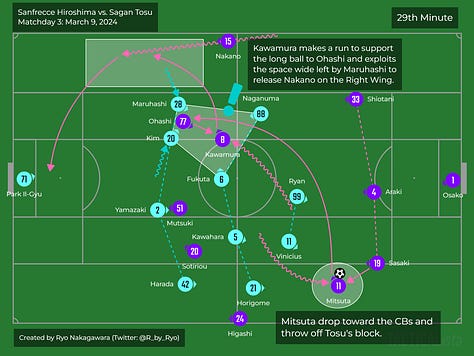


Keisuke Osako also warrants a mention for a very good season as even when Sanfrecce’s formidable defense was breached, he was usually equal to the opportunity with some stunning saves throughout the season. Although he is getting just acclaim as he is a regular call-up to the senior national team by Moriyasu, an actual start ahead of Zion Suzuki was still elusive throughout the World Cup qualifiers so far. It might be motivation for Osako to finally get a move to Europe soon…
In central midfield, the big story was the return of Hayao Kawabe from Europe and he slotted in seamlessly into the double pivot. His experience and skills was invaluable in the title run-in. Taishi Matsumoto was another player who has really grown under Skibbe’s guidance and shown his worth. Yotaro Nakajima is a name that’s been on a lot of people’s lips, especially for keen observers of the Japanese youth national teams. The teenager has been drip fed minutes in the league while mainly completing games in the ACL 2. With the movement of Japanese players to abroad only accelerating, it’s only a matter of time before Nakajima starts getting regular league minuets as well. I will mention though that I think a big problem for Sanfrecce was that they never quite had a “proper” defensive midfielder aside from Tsukasa Shiotani occasionally filling in there (even then he’s still primarily a defender too).
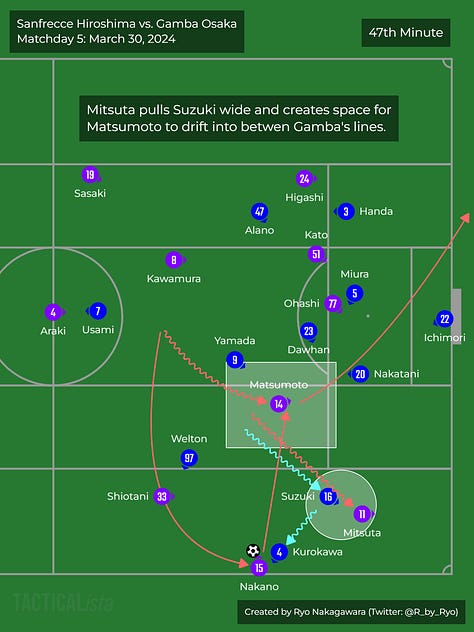


Along with Kawabe, the other surprise was the arrival of Tolgay Arslan. I don’t think Skibbe and the staff were really banking on Arslan hitting such rich vein in form so I think they were as surprised as any of us. The German scored 8 goals in just a little over 800 minutes and mostly in August-September before he was even fully integrated into the starting XI! The player that lost out because of this was Makoto Mitsuta, who in the last eight matches of the season in only came off the bench in the league while occasionally starting the ACL2 games. It was another mixed season for Mitsuta who was once again forced to play Wing Back or even in the double-pivot at times to accommodate others. Marcos Junior was similarly anonymous but across the entire season with only 3 starts and 12 match appearances in the entire league campaign.
Up top saw a major change with Yuki Ohashi's departure to Blackburn Rovers in the summer. Although Mutsuki Kato finally started scoring goals commensurate with his xG, it’s still a fact that he was lagging behind overall. Including penalties, Football-Lab had Kato on 9 goals from 11.22 xG while FotMob had him on 9 from 13 xG which shows you just what Sanfrecce were missing throughout the season. In defense of Kato, he did provide a whole lot of other things besides his goal scoring. Kato was a very willing runner that stretched opponent defenses and also contributed with a vital 7 assists! Gonçalo Paciência did score 2 goals but he came a bit too late to have a discernible impact. In the end, it was a pretty damning indictment of Sanfrecce’s profligacy that Yuki Ohashi remained their top goal scorer throughout the entirety of the 2024 campaign, albeit both Pieros Sotiriou and Mutsuki Kato were only a goal behind on 9 apiece at the end of the season!
Sanfrecce took the most shots in the league by a considerable amount, nearly over 130 more than the next most team, Marinos. However, a lot of these shots weren’t the best quality as Sanfrecce’s xG per Shot was only 0.092, 13th best in the league. Even still, just the sheer volume of shots did mean that they did create the most xG in the league (if you add small xG values a bunch of times you still get a large total… eventually!). Watching Skibbe’s Sanfrecce over the years, most games they struggled to truly break teams down and create high quality chances, simply electing to scatter shots from whatever distance or situation. On top of that, when they actually did create good chances, they usually missed them! So then despite their pretty good defense overall, they happen to leak goals… which then only increased their desperation and low quality efforts at the other end. This has been the one very clear issue for Skibbe’s Sanfrecce and if you’ve been following these season reviews for a while now, you’d know that this is something I’ve complained about before.
It is quite funny to me that despite this, overall Sanfrecce actually scored more goals than their xG this season but most of this was powered by Arslan (8 from just 4.02 xG), Shuto Nakano with 5 from 2.9 xG, and the now-departed Yuki Ohashi with 11 from 8.9 xG while everybody else was their usual profligate selves.


As the season wore on, Sanfrecce also had to contend with their participation in the Asian Champions League 2. Although in many games they played a B or C string side (and won fairly comfortably, I might add), a lot of first teamers still did travel with the matchday squad and I do think this became a hindrance to their J1 title aspirations. This was very apparent in their game against Urawa (after a mid-week game in Sydney, Australia) where they looked out-of-sorts defensively in the 2nd Half in a way which I really hadn’t seen Hiroshima be. However, it still speaks to the quality of the team that they still could’ve won the game if they had finished their chances.
To not be making too many excuses for Sanfrecce, I will say that a lot of this could’ve been avoided if they were far more clinical far earlier in the season from Mutsuki Kato and others. People will recall that although Sanfrecce were unbeaten in the first 11 games of the season, they had drawn a whopping seven (7) of those games! They finished only 4 points behind winners Kobe, I think you can do the math. It’s been a very dominant three years for Skibbe’s Sanfrecce but the fact remains that all they have to show for it so far is a solitary league cup title from back in 2022.
Other data viz:
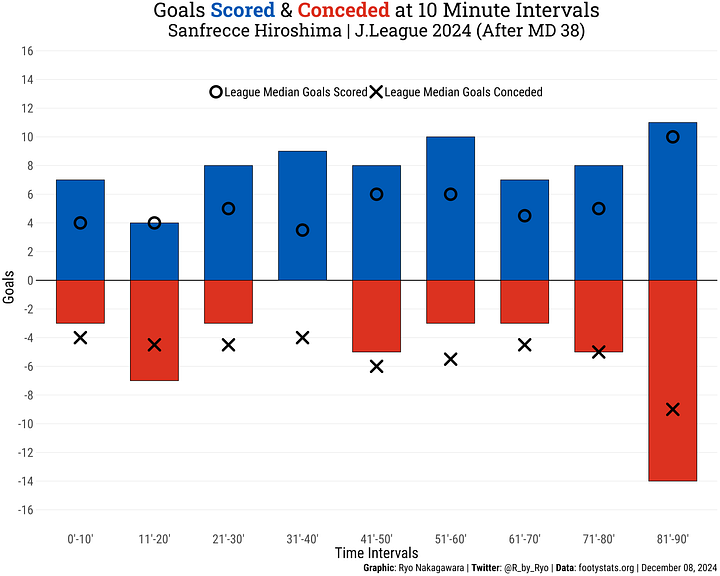



Machida Zelvia (3rd, 66 points)
19 Wins // 9 Draws // 10 Losses
Location // Stadium: Machida // Machida GION Stadium
Manager: Go Kuroda
54 Goals (6th); 34 Conceded (1st)
43.96 xG (11th); 34.5 xGA (2nd)
Top goal scorer: Shota Fujio (7 goals plus 3 penalties)
Goalkeeper: Kosei Tani
Machida Zelvia and manager Go Kuroda caused a big old ruckus to shake things up in J1 this season! At the halfway point of the season, Zelvia were actually in first! However, things started creaking with Yu Hirakawa’s departure and then the new summer signings not quite gelling. Just the two wins in 12 games between matchday 24 in late July to matchday 35 in early November was ultimately their downfall. Despite this, Machida were still within an outsider shot for the title on the final matchday as both Vissel Kobe and Sanfrecce Hiroshima stumbled a lot as well! Ultimately though they finished 3rd mainly on the back of their great defending. Their underlying xG numbers were somewhat in flux throughout the season especially in attack where they were very streaky and relied on good finishing.


Contrary to some people, I do think their defense was still fine, very good even, throughout the latter half of the season. Kuroda made adjustments throughout the season depending on the opposition and really drilled their defensive shape. The great understanding between the players on how to stay compact, who covered for who, etc. was a testimony to Kuroda’s effectiveness as a coach.
A big part of this was the upgrades to a J1 standard that Machida were able to afford in the shape of Gen Shoji (chosen as a candidate for the J1 2024 Season Best XI) and Ibrahim Dresevic. I thought that Machida’s defenders were already pretty decent in J2 last season but these two definitely raised the level of their defending. Another surprise was Henry Mochizuki’s powerful performances, to the point that he was getting called up to the senior Japan national team in the autumn.


In midfield, the emphasis was on a lot of graft as Kai Shibato, Hokuto Shimoda, Keiya Sento, and later Ryohei Shirasaki all provided the running, tackling, and ball recovery that was vital to Machida’s attack and defense. It was quite nice seeing Hokuto Shimoda again, I quite liked him at Frontale and was surprised no one in J1 went for him when Oita got relegated a few years back and it’s clear he still has what it takes at the J1 level.
Chopping up Zelvia’s season into two completely even halves like this is a bit arbitrary but it’s the least arbitrary method so:
xG: 23.59 to 20.37 (1st Half of the season to 2nd Half of the season)
Goals: 31 to 23
xGA: 15.89 to 18.61
Goals Against: 16 to 18
xG Difference: 7.7 to 1.76
Goal Difference: 15 to 5
So sure, their xGA was just slightly worse in the 2nd Half of the season but more importantly, Machida weren’t able to score as efficiently as they did in the 1st Half. The drop off between scoring 31 from 23.59 xG to just 23 from 20.37 was a pretty big swing when you look at how tight the scorelines in Zelvia games usually are.
Whatever you want to say about Machida’s attack, it was very clear what was being asked of the players and Kuroda coached them well so that every single player knew exactly what they needed to be doing. Like I mentioned in the mid-season review:
Pump long balls to their big strikers (Oh S.H., Duke, Fujio, etc.).
Win the initial aerial or pick up the 2nd/loose ball (Sento, Shibato, later Shirasaki and Shimoda).
Spread it wide to their Wide Midfielders or Full Backs bombing up (Hirakawa, Hayashi, etc., later Mochizuki, Soma, Fujimoto, etc.).
Cross it into the box (open-play or set-pieces) or long throw-in attempts.
Score… or if not, knock back or collect clearances and start again from Step 1.


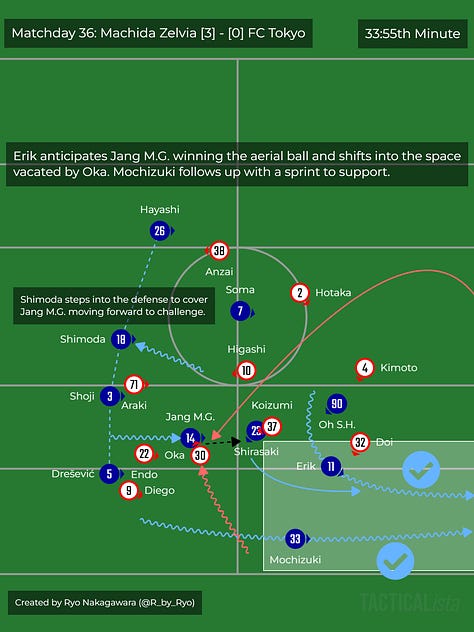
It was a fairly left-slanted attack mainly due to the fact that striker Oh Se-Hun usually liked to drift out left to receive the ball. Kazuki Fujimoto was quite good out on the Left Wing with his direct dribbling from picking up loose/2nd balls and he finished the season with 3 goald and 3 assists. The experienced and European league returnee Yuki Soma picked up the slack from the summer months in a variety of attacking positions and his solitary goal was directly from a corner kick against FC Tokyo.
Of course, the chances they created from this style of play weren’t usually of very high quality nor quantity so they were very reliant on any one of their players having a hot run of form in front of goal to actually score goals. To me, this was what was happening in the 1st Half of the season where they scored their 31 goals from just 23.59 xG. When playing in the way Machida did, you’re always playing by very fine margins, so when that little bit of luck and good finishing stopped going their way for a variety of reasons Zelvia really struggled. The only thing Machida could do in these situations was to simply double-down and try to brute-force things even more and maybe earn themselves a set-piece or penalty which was indeed how they scored a lot of their goals anyway.
I suppose I can’t go talking about Machida Zelvia without touching on the … on/off-field incidents with lots of errr… gamesmanship, perceived (and actual) rough play, “Towel Wars”, and the post-match comments of Go Kuroda and certain players being a big part of the discourse throughout this J1 season. At the finish line, Machida couldn’t even justify their antics through an actual championship win so I suppose a lot of heat will rightfully continue to go their way. Contrary to what others think, I don’t think this had any impact on Machida’s play on the pitch as indeed they simply doubled-down on it instead! Nevertheless, finishing 3rd and being in the title race until the last matchday as a promoted team was still an excellent season for Machida Zelvia. Go Kuroda will be back next season with more brick-wall defending and on/off-the-ball shenanigans to entertain or infuriate us all in 2025!
Other data viz:




Gamba Osaka (4th, 66 points)
18 Wins // 12 Draws // 8 Losses
Location // Stadium: Osaka // Panasonic Stadium
Manager: Dani Poyatos (Spain)
49 Goals (10th); 35 Conceded (2nd)
46.28 xG (9th); 47.36 xGA (13th)
Top goal scorer: Takashi Usami (8 goals plus 5 penalties)
Goalkeeper: Jun Ichimori
A big surprise was Gamba contesting for the title for a good chunk of the season . I imagine improvement was to be expected after the horror show of 2023 but even the most optimistic Gamba fans weren't expecting this! A key to their revival this season was a new found defensive solidity (well for the most part…) and being far more organized on both sides of the ball. Shinnosuke Nakatani was probably one of the best signings of the season, indeed he was selected as one of the candidates for the J1 2024 Season Best XI. He not only brought a lot of defensive steel but contributed on the ball too. Shota Fukuoka has stepped up considerably to partner Nakatani after Genta Miura went down injured for most of the season. I really liked him at Tokushima Vortis so it’s nice to see him nail down the starting spot in the past two seasons (I do think he should’ve played more under Katanosaka).
The overall xG numbers don’t show too much of a difference between the two seasons but when you look at the quality of shots conceded you see a marked change. Tactically, Gamba seemed more willing to form a lower/deeper block this season and by the data they were much more successful in not letting opponents take good shots on average (even if the xGA in total was higher this season than in 2023). This is another situation where I wish I had more granular data because the simple xG data and number of shots I have aren’t giving me the full picture especially when paired with how I have conceptualized Gamba in my head from directly watching them this season.




Anyway despite saying all that, Gamba still needed a lot of help from their goalkeeper. Jun Ichimori was a huge asset on his return to Gamba Osaka after showing he could handle the rigors of J1 in a very good 2023 season on loan at Marinos. He proved to be one of the best shot-stoppers in the league. Indeed, Ichimori was actually on top when it came to the “Goals Prevented” stat as he only conceded 34 goals from 41.7 xG On Target (Source: FotMob). This was all in addition to the calmness he exhibited in circulating the ball with his fellow defenders, a quality which had been missing in Gamba for the past few years under multiple different managers.
Dawhan helped Gamba on both sides of the ball throughout the season with his involvement in attack from charging into the box along with his general all-roundness that was supported by his great physical acumen. Tokuma Suzuki (another ex-Vortis player I’ve liked) also contributed a lot defensively along with his great spatial awareness in the build-up, and of course his technique.


On the other hand, I don’t think their attack was very great this season despite some tactical tweaks and the acquisition of actual dangerous wingers like Yamashita and Welton. Once again, Gamba relied heavily on Takashi Usami’s heroics, most notably in the game against against Consadole Sapporo. Even if you take into account that 5 of Usami’s 12 league goals have been penalties, he also had 8 assists. With a total sum of 20 goal contributions, basically he was involved in nearly half of Gamba’s total goals scored!
Coming back to the wingers, Ryoya Yamashita and Welton were a breath of fresh air compared to what Gamba had last season. While Welton had 4 goals and 5 assists, I do think Yamashita really needs to step up his output as while his pure speed lets him onto some dangerous counterattacks, he struggles with his finishing. Indeed, he only scored one goal this season which I think should’ve been much higher.


Isa Sakamoto was an interesting player as this #9 and #10 in-betweener. He was really good at connecting stuff together from midfield to attack by receiving in good spaces then turning to drive forward but not really getting a whole lot of shots or directly creating stuff in the final 3rd. Despite his (relatively) low number of shots compared to other “forwards”, he still managed 10 goals from 7.6 xG. It’s a curious profile to be sure!
As I alluded to earlier, further forward the attack completely stalled out and contributed to Gamba falling away from the title race. They only won a single game in a ten game period stretching from mid-July to October, including being held goal-less in 4 games out of those 10 games! They slightly recovered in the last two months or so of the season but the damage was done. Most of their attack consisted of their wingers flying down the flanks as individual contributors but otherwise they struggled for ideas to break teams down besides the occasional Usami magic.


To end their season, Gamba were excited at a prospect of an Emperor’s Cup title but ended up with a very frustrating loss to Vissel Kobe in the final after playing fairly well despite the absence of Takashi Usami. Although the last few months of 2024 were disappointing, it's still a remarkable change from the 2023 season and should give Dani Poyatos enough of a leeway to continue on at Gamba and gear up for a proper title charge next season.
Other data viz:

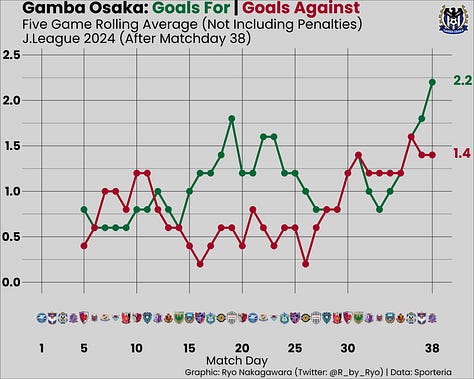




Kashima Antlers (5th, 65 points)
18 Wins // 11 Draws // 9 Losses
Location // Stadium: Kashima // Kashima Soccer Stadium
Manager: Ranko Popović // Chugo (from September)
60 Goals (5th); 41 Conceded (5th)
43.22 xG (13th); 43.77 xGA (9th)
Top goal scorer: Yuma Suzuki (9 goals 6 penalties)
Goalkeeper: Tomoki Hayakawa
Ranko Popovic was fired along with the sporting director (Muneshige Yoshioka) right after a 4-0 win against Albirex Niigata in early October! On top of surprise breakout star Kimito Nouno getting injured for the rest of the season in September… it was yet another season of Kashima imploding in the middle of the season! The thing with Kashima over the past few seasons is that the stats have never been convinced by them. Antlers owe a lot to the quality of the attackers they have that are able to consistently finish chances above their xG value rather than consistently creating many or good quality chances as a team.


Kashima’s strategy revolved around Yuma Suzuki as usual. His excellent ability to drop deep, provide lay-offs, and physicality to win the initial or second balls in the air or ground was the foundation of most Kashima attacks this season (and many previous years too). In support to Yuma’s movements, usually he drifts out to the left, were the lung-busting runs from the likes of Shintaro Nago, Shu Morooka, and Hayato Nakama. Shu Morooka in particular would move into the striker space whenever Yuma drifted wide and he was the usual target in the box once the ball was crossed inside. He was also a good dribbling threat starting out from wider areas as well. Jubilo fans must rue their transfer ban as Morooka was genuinely a good J1 level player this season!



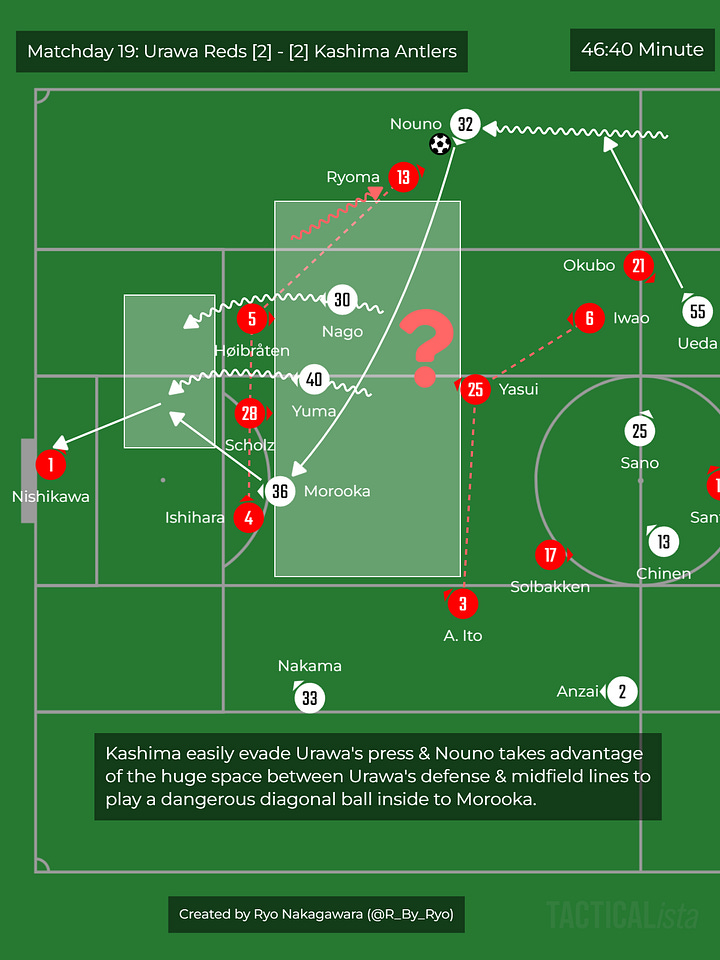

Despite all this movement and interchanging of positions, and the nice combination play that would result in the final 3rd, it was also clear that Kashima weren’t consistently creating enough chances nor good quality ones when they did. Kashima really relied on excellent finishing along with Yuma Suzuki taking lots of penalties.
Kimito Nouno was pretty good in his debut season but his goal scoring has led to an over-inflated evaluation in my opinion, especially when you consider that his 9 goals came from just 4.2 xG (Source: Football-Lab). Nonetheless, he made plenty of good runs to get into the final 3rd and be a recipient of the long passes and long diagonals that Kashima love to play. I think he integrated into the team extremely well for a rookie so it’s a real big shame about his injury.



Of course, for all the talk about Nouno, we can’t forget that the biggest attacking threat probably comes from the opposite flank in the form of Koki Anzai. Once again the Left Back was audacious, extremely aggressive in how high up he would position himself to send in many dangerous crosses into the box. Even so it’s weird that he only ended up with 2 assists, although you can say that’s more on the attackers along with the fact that he simply created value through 2nd/loose balls from those crosses as well.
On the defensive side of things, Kashima were fairly decent but there were some very clear weaknesses as well. With how attacking the Full Backs were, it left a lot of space behind to be exploited. This in turn meant that the Center Backs were frequently forced wide to cover, which then meant less presence inside Kashima’s own box. I feel like Kashima had issues in defensive transition without Kaishu Sano, not just in terms of physically covering ground but having that defensive awareness and prevention ability. Despite Kei Chinen’s industry and surprising role change into a midfield destroyer, I feel this is an aspect where he struggled. Opponent teams were able to exploit the usual weaknesses of a 4-4-2 mid-block as well.

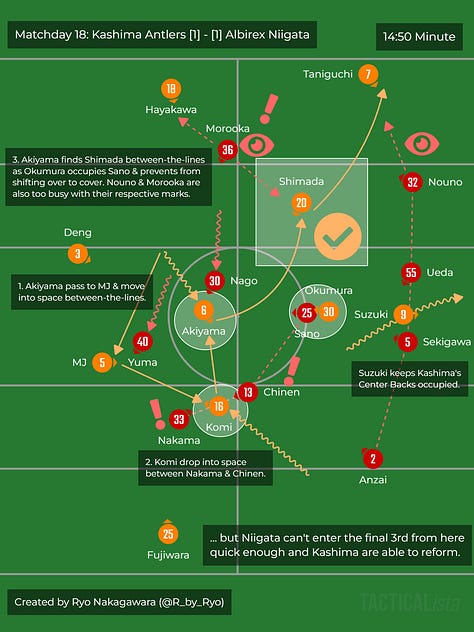




Kento Misao returned to the club but was mainly played as a defender rather than in midfield, much like the season before he left where he was filling in at Center Back. Of course, in the final matches of the season this was more due to Kimito Nouno’s injury. Ikuma Sekigawa, a player I’ve quite liked in the past (see my old blog about his great partnership with Koki Machida a few years ago), hasn’t quite pushed on to become that elite J.League tier Center Back I thought he would be. I think he’s still very good and his partnership with the experienced Naomichi Ueda was fairly solid. Their accuracy in their long feeds forward fit the tactics really well. Tomoki Hayakawa is a decent J1 level goalkeeper, I don’t really have much more to say than that. I can’t see him getting National team call-ups unless it’s the EAFF cup squad.
The entire club from top-to-bottom was a real mess and it's going to take the new sporting director Koji Nakata and the new manager a lot to turn this club around. It’s a squad with that’s quite thin in key parts of the pitch so there’s an immediate task there.
NOTE: Kashima Antlers announced that Tohru Oniki will be taking over as manager for the 2025 season!
Other data viz:
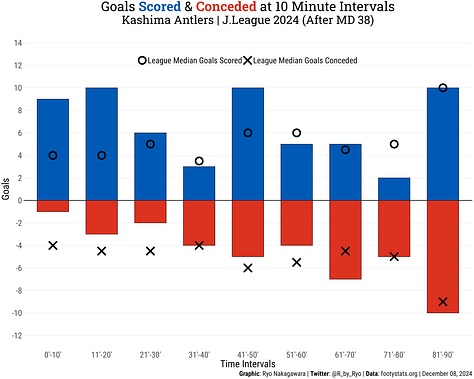




Tokyo Verdy (6th, 56 points)
14 Wins / 14 Draws / 10 Losses
Location // Stadium: Ajinomoto Stadium
Manager: Hiroshi Jofuku
51 Goals (9th); 51 Conceded (10th)
40.26 xG (16th); 37.52 xGA (3rd)
Top goal scorer: Yudai Kimura (8 goals plus 2 penalties)
Goalkeeper: Matheus Vidotto
Verdy had an extraordinary season back in the top flight for the first time since 2008. After being surprise winners in the promotion play-offs last season, most people had them battling relegation this season but instead they have punched far above their weight. It took them some time to get fully going and while they would occasionally get blown out by top teams, for the most part they kept the score low and showed a lot of grit to keep the game close even when they lose. Verdy only lost two games (vs. Shonan and a crazy game vs. Kawasaki Frontale) since mid-August (matchday 26) to finish the season strong!


Verdy’s build-up and possession play stabilized considerably once Jofuku moved away from the 4-4-2 that they used in J2 and instead settled on a Back 3 with Koki Morita and Kosuke Saito supporting them quite closely with Tomoya Miki hovering into open spaces further forward. I do feel this was probably Verdy’s strongest part of their squad (the attackers are mostly on loan so I’m not counting them, yet). With the captain’s armband Koki Morita has really taken the club on his shoulders and his ability to be in the right position to receive the ball and distribute it has been very good. Kosuke Saito was interesting in that he dropped much deeper compared to where he was playing in the past but still makes really good forward runs when needed in support of Verdy’s attackers as well.
However, while Verdy circulated the ball safely enough and also always having the option to go long if need be, they really struggled once they got past the Half Line. They just didn’t really have enough guile on the ball to threaten or enforce their will on the game. Verdy were very reactive and got their best opportunities from forcing turnovers, so a lot rode on the attackers making some magic work on the counterattack every game.
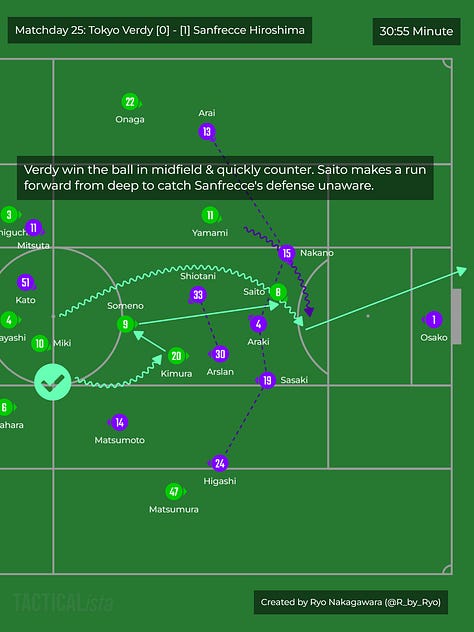




Hiroto Yamami finally fulfilled the promise he had shown at Gamba Osaka, 7 goals and 6 assists but from only 13 starts despite his overall 33 appearances. Next step will be to do all this as a consistent member of the starting line-up instead. It’s crazy to me that (at the time) fellow relegation candidate Kyoto Sanga were willing to give Yudai Kimura up to a relegation rival. Kyoto’s loss was Verdy’s gain as Kimura was very strong physically, holding the ball up, and being the platform for Verdy’s counterattacks or long balls. Itsuki Someno has been a familiar face for Verdy fans as he’s been with the team since last season down in J2, not the most flashy player but works really hard.
Verdy’s strong point has been their defense, especially after the switch to a Back 3 // Back 5. Hiroto Taniguchi was a rock on the Left of the Back 3 and showed a lot of good technical skills on the ball as well with his involvement in Verdy’s build-up play. Yuto Tsunashima was probably the biggest benefactor of the switch to a Back 3 and was a huge upgrade in defense as the season progressed. In terms of the Wing Backs I was impressed with Hijiri Onaga’s tireless running down the Left flank. The thing about Verdy’s defense was that it wasn’t just about the individuals but how they all performed well as a unit. Even when their first line of press was broken, everybody tracked back hard and there were lots of strategies in place for who needed to be covering for whom.





It’s quite clear Hiroshi Jofuku is the perfect manager for where Verdy are now as he wrung about every last drop of juice from this “on paper” limited squad. Still the clear ceiling in talent level is still there and that's something Verdy will need to improve upon if they want to go further on and start challenging for an ACL place or even a title race. All-in-all it was a fantastic season for Verdy and one that they can build upon and re-establish themselves as a proper J1 side. However, there are big questions in the transfer market as a lot of their best players in attack are all on loan like Yamami, Kimura, and Someno!
Other data viz:





FC Tokyo (7th, 54 points)
15 Wins // 9 Draws // 14 Losses
Location // Stadium: Tokyo // Ajinomoto Stadium
Manager: Peter Cklamovski (Australia)
53 Goals (tied 7th); 51 Conceded (tied 10th)
41.54 xG (14th); 45.64 xGA (11th)
Top goal scorer: Ryotaro Araki (6 goals plus 1 penalty)
Goalkeeper: Taishi Nozawa
Despite what to me was an awful season, FC Tokyo somehow managed to finish in 7th... Yeah, I can't believe it either! There was a a horrible nine game stretch across three summer months where the team only won once including an awful losing and goalless streak. This was then immediately followed by an extremely fortuitous five game unbeaten run. FC Tokyo is an inconsistent team that constantly takes 3 steps back for every 2 forward!


A big problem was investing in a bunch of half-fit attackers while completely disregarding the defense, on top of selling Tokumoto just when he was getting into good form! There were lots of injury issues at the back as well which only exacerbated the cohesion and chemistry in the squad throughout the season. The fact that only Masato Morishige, Tokyo’s oldest Center Back, had the highest number of starts out of the Center Backs, and only 19 at that, was a huge problem. Kashif disappeared due to his millionth injury in the second half of the season. Kanta Doi looked really promising alongside Trevisan but they both got injured for multiple months. I feel as though if both were fit for the entire season that Tokyo would’ve looked much better as I really like the two despite their faults.


Yuto Nagatomo wasn’t trusted to start as the season ended so Teppei Oka took up the Left Back spot a lot in the final months of the season despite mainly being a Center Back. Everybody knows about Hotaka Nakamura’s persistent injury issues while Kosuke Shirai gets a knock every now and again as well. It’s no wonder FC Tokyo can’t build up from the back when the Back 4 is changing every week!
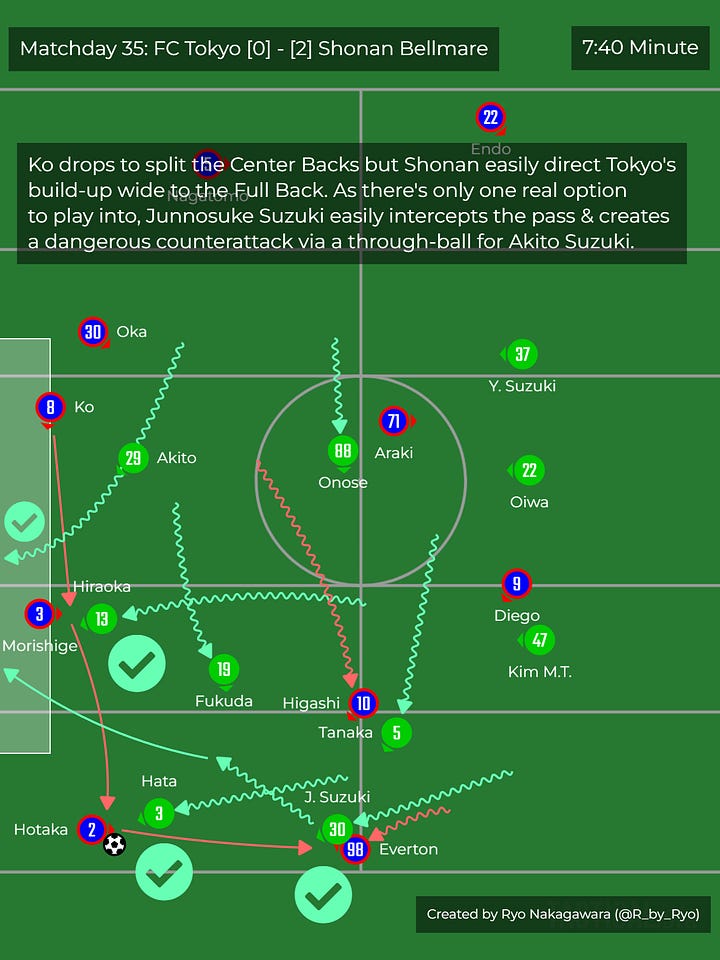

On top of this, the pressing never quite worked at all this season (…or in past seasons honestly). All it did was it kept Tokyo’s midfield pushed up far too forward and unable to help the defense when the press was inevitably broken, without too much effort from the opposition too I might add! Overall, there was a distinct lack of coordination and understanding between players when it comes to defending across different situations (not helped by the aforementioned injuries). I feel like this is an aspect that Tokyo has really lost as the club moved away from the Kenta Hasegawa era. The team as a whole were stuck in a low-block far more than they would’ve liked.




Takahiro Koh was a revelation in midfield. His acute positional sense really strung things together but there’s only so much one guy can do to help the build-up on top of the fact that Tokyo should’ve bought him or someone like him far earlier into the post-Hasegawa era. Kei Koizumi battled hard and covered ground all season. I will say it was nice that he stopped being forced to play at Right Back too. Keigo Higashi, every time we think we’ve seen the last of him he keeps popping back into the line-up due to the fact that a player has been sold (Kuryu Matsuki this season, Shuto Abe prior) or got injured (Takuya Aoki a few seasons ago). To be fair to him, I don’t think he’s been particularly bad (but still not good, mind you…) but Tokyo should’ve moved him and quite a few of the other veterans out years ago!
This is the major problem with FC Tokyo, despite all the fanfare about “change” and transitioning to “attacking football”. The players from the “old era” have remained on the books, the coaching staff hasn’t changed, and Tokyo have been in the bottom half for “shots taken” in every single year since separating from Kenta Hasegawa! In 2024, FC Tokyo took the 4th least amount of shots in the league and conceded the 5th most!


While FC Tokyo had to keep falling back on veterans for a variety of reasons, one positive thing with Cklamovski that I will note is that he did attempt to give a lot of playing time to youngsters but the issue was their performances and quality were varied and inconsistent. Besides the aforementioned defenders like Oka and Doi, Kota Tawaratsumida and Soma Anzai were given plenty of game time as well.
Kota Tawaratsumida is an exciting player with great dribbling but the fact remains that he lacks end product and hasn't really pushed on to improve this season. The young winger completely lost his starting spot in the team in the 2nd half of the season with only 2 goals and 3 assists to show for his efforts. I’m not a huge fan of Soma Anzai. He is not much help in the build-up from deeper, isn’t much of a progressive passer in the midfield, on top of being fairly ineffective at creating chances. He’s ended up with 4 goals because he runs around a lot but he’s missed plenty as well. The biggest positive is that he has a high workrate but I’m not really sure where he should be playing as he’s not threatening enough as a Winger and not defensively good enough as a Full Back.


In a departure from the more controlled possession game under Albert Puig, Peter Cklamovski’s style was more quicker and vertical. To me, it seemed like FC Tokyo were trying to compromise between the “FC Tokyo” DNA of fast quick counterattacks while mixing in some more of the possession-based ideas that the club has aspired to. The main thing about Cklamovski’s Tokyo was that they wanted to create lots of artificial transition moments. Basically:
Try to pass it around the back, lure opponents to press Tokyo’s defenders to create space behind.
Then when Tokyo get around the halfway line, try to quickly pass it across from one side to another. Either through one of the double-pivot or the Full Back on the opposite side inverting as the link.
Then play through-balls or long diagonal balls to the Wingers into lots of space to go 1v1 and cut inside to shoot or dribble down the line to cross!
You can also go listen to my J-Talk Podcast cameo in November (discussing Matchday 36) where I discuss this and other FC Tokyo issues at length.
When it worked it looked fantastic because FC Tokyo absolutely do have the quality wingers to play this way with the dribbling skills of Teruhito Nakagawa, Keita Endo, and Kota Tawaratsumida. It’s exciting to see them fly down the wing and the Tokyo crowd get really behind it. However, most of the time instead Tokyo get pinned inside their own half, lose the ball in the defensive 3rd or forced to chuck the ball away because Tokyo's defenders can't deal with pressure very well!
Another problem this style of play had was that at times it felt like FC Tokyo attacked a bit too quickly. To the point where there wasn’t a whole lot of options inside the box and it would take a near impossible, pin-point, thread-the-eye-of-the-needle type pass/cross to create a chance. In effect Tokyo “spend” so many players building the ball up that there’s not a whole lot of players further forward to actually do the damage!




Sometimes it still worked out because Tokyo do have talented players that can do a lot individually while outnumbered but again, it’s not consistently replicable. Given how little amount of shots FC Tokyo took, the players had to be extremely clinical. I feel like this clinicality, this efficiency, masked a lot of Tokyo’s poor performances this season. Talking about clinical, Ryotaro Araki had a very good season where he got his mojo back, even to the point where he earned U-23 national team call-ups to win the U-23 Asian Cup and star at the Olympics. 7 goals from 5.14 xG and 4 assists from the boy wonder. Unfortunately, it’s going to be hard for FC Tokyo to keep a hold of him especially with the grand scale changes at parent club Kashima Antlers.
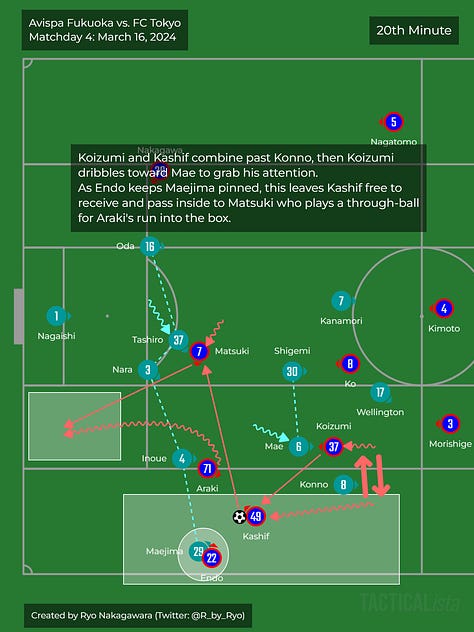


Overall, this was a disastrous season for FC Tokyo.
Finished below Tokyo Verdy for the first time in 23 years!
Finished lowest in the table compared to the other “Tokyo” club (quotation marks for emphasis, not for any other reason I promise) in Verdy and Machida, both teams who were promoted this season!
Continued the awful trend of taking very few shots per game throughout the season!
etc…!
Oh, also Diego retired. I’m very depressed as he was on my first FC Tokyo uniform. Anyway, Peter Cklamovski was let go… but there are still many other problems clouding the club which should worry FC Tokyo fans extremely. At this point, FC Tokyo can hire Pep Guardiola but this team won’t get anywhere in my opinion without a huge overhaul to other parts of the team’s infrastructure and staff!
Other data viz:



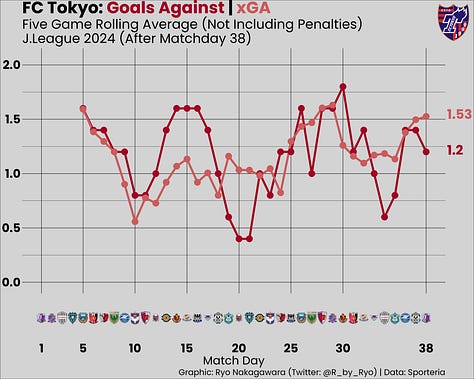


Kawasaki Frontale (8th, 52 Points)
13 Wins // 13 Draws // 12 Losses
Location // Stadium: Kawasaki // Todoroki Athletics Stadium
Manager: Tohru Oniki
66 Goals (2nd); 57 Conceded (14th)
60.79 xG (2nd); 53.06 xGA (16th)
Top goal scorer: Shin Yamada (17 goals plus 2 penalties)
Goalkeeper: Jung S.R.
After 8 seasons, 4 J.League titles, 2 Emperor’s Cups, and 1 J.League Cup, Tohru Oniki left Kawasaki Frontale as one of the most decorated managers in the league’s history. However, it’s been rough to watch these past two years as many players left and the team just couldn’t rebuild properly with quite a few long term injuries to the remaining key players. After two consecutive mediocre mid-table finishes, it became time to move on.


At striker, winter signing Erison started the season brightly but an injury put a stop to his momentum while Bafetimbi Gomis continued to not impress. Indeed, the Frenchman abruptly left in the middle of the season. In their stead, it was Shin Yamada who won a starting spot and scored 19 goals to lead the team. A powerful dribbler that can push his way past defenders with his great balance and upper-body strength. There are plenty of concerns about his out-of-possession skills which leads him to have performances that are very all-or-nothing but there’s only so much you can say about a guy who was in the running for J1 top goal scorer.
Marcinho as usual stretched opponent defenses with his speed and trickery from the Left Wing while Akihiro Ienaga drifted around as more of a floating #10 from the Right Wing. Occasionally the likes of Daiya Tono and Yusuke Segawa popped here in rotation or as substitutes. While Shin Yamada and Erison kept scoring goals, it didn't help camouflage the clear problems of the team out-of-possession as in defense things have looked poor, especially when it comes to defending from the front. Nevertheless, it is a fact that Frontale have scored the 2nd most goals in the league, which makes sense given they were the league leaders in entering the final 3rd and the opposition box while firing off the 3rd most shots in the league (2nd most for shots on target)!


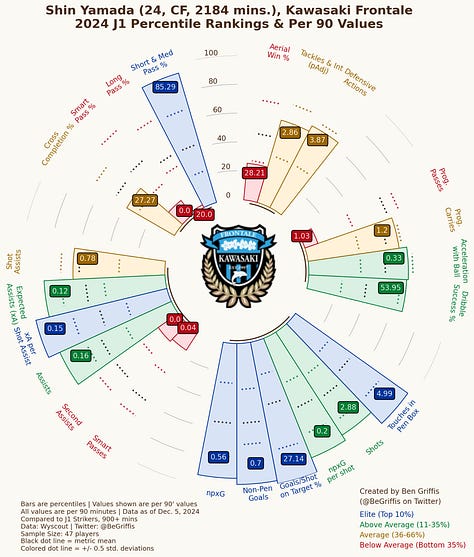
As J.League viewers have seen throughout Oniki’s tenure, Frontale were the team when it came to dominating and suffocating opponents by pushing them back into their own defensive 3rd or box with Frontale's superior technique and ball keeping skills. New "big" signing from Gamba Osaka, Yuki Yamamoto, was supposed to be a key piece in a new-look Frontale but barely featured after a poor start. As such the midfield were the usual suspects in Kento Tachibanada and Yasuto Wakizaka with cameos from the now departed Tatsuki Seko. Wakizaka has been one of the best creators in the J.League across the past five or so years. It's been a great mystery as to why he hasn't made the move abroad but he seems to love being at Kawasaki. Basically the heir to club legend Kengo Nakamura in midfield with his great technique and passing skills, Wakizaka notched 5 goals and 3 assists in the league this season.
Ryota Oshima also returned from his long injury troubles… and then promptly got injured again (and again)... Winter signing Ze Ricardo had a few decent cameos but fell out-of-favor. One big success has been the mid-season signing of Sagan Tosu’s So Kawahara. Kawahara has been highly lauded for the past few years now and made the step up to a “big” J1 club in the summer.
With the constantly shifting back-line, Frontale really struggled to build-up from the back in the past two seasons which used to be one of their main highlights in my opinion. Center Back has been a problem position for the past few seasons as star defender Jesiel continued to be plagued by injuries. Summer loan signing Cesar Haydar wasn’t trusted much while veteran back-up Yuichi Maruyama was mostly injured since his arrival last winter. Takuma Ominami played Centrally and at Right Back but left for OH Leuven in Belgium in the summer. Asahi Sasaki, who had mostly played Left Back up to the start of this season, filled in at Center Back quite a bit this season and honestly, he did surprisingly well!

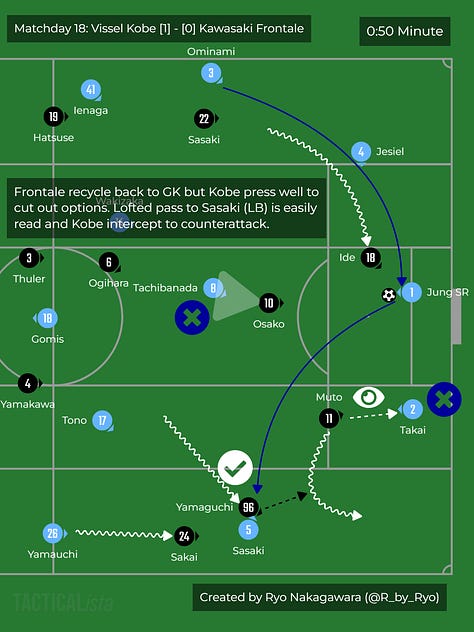



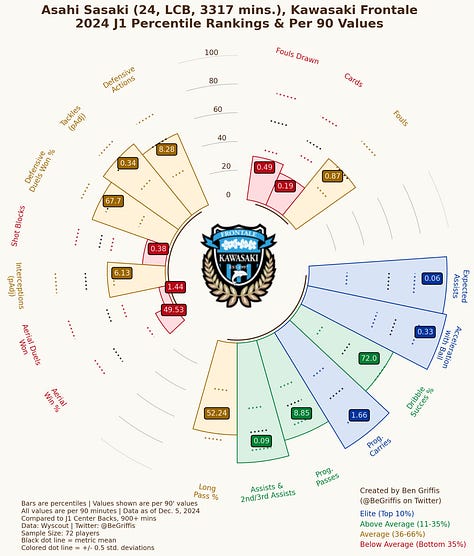
All these issues saw the rise of teenager Kota Takai in the starting line-up. He would be quite well-known to many close observers from his youth national team appearances, especially in the U-23 Asian Cup and the Olympics this year. A tall and aggressive defender with incisive passing who made his debut with the senior national team in September.





Occasionally, you see glimpses of the smooth swash-buckling passing moves that became Frontale's trademark early in Oniki's tenure but it's been very inconsistent this season. In recent years the Full Backs moved a lot more, inverting or keeping wide, to receive the ball in the build-up phase and their mobility was key as they also need to get involved in the final 3rd. When Sai van Wermeskerken and Sota Miura were fit and available, Frontale looked far more fluid due to their support in attack. However, with injuries also plaguing these positions, Kento Tachibanada & Yusuke Segawa filled in from their usual midfield spot along with the aforementioned Ominami.
Historically, Frontale play a 4-3-3 but especially from around mid-season this year, they switched to a 4-2-3-1. This was mainly due to the fact that the single-pivot was overwhelmed defensively and a switch to a double-pivot was meant to stabilize things in-and-out-of-possession. Nonetheless, Frontale still did struggle defensively as teams could now exploit the usual gaps that appear in the midfield four of a 4-4-2-ish shape as the #10 moved up alongside the striker to keep an eye on opponent Center Backs. The defensive structure was a mess whether in the block or the press and opponents had an easy time pushing forward. I’m not sure how much I should blame the strikers or others in the squad when a lot of it seems to be a strategic flaw in the game-plan.








Tohru Oniki not only played and retired at Kawasaki Frontale but also helped the club to win their first ever league title and won every title available to a J.League club side with the exception of the Asian Champions League in his 8 year tenure. I imagine there will be plenty of player turnover as well over the winter but all eyes are on who will end up managing Kawasaki Frontale next. Huge changes yet to come…!
NOTE: Shigetoshi Hasebe has been confirmed as Kawasaki Frontale’s new manager!
Other data viz:



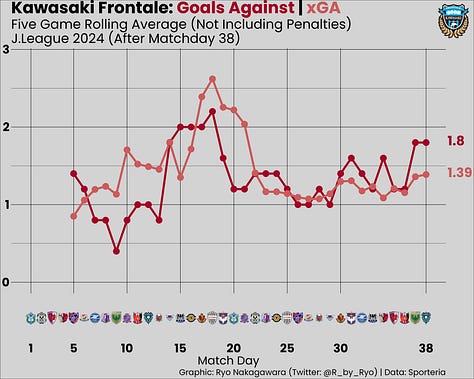

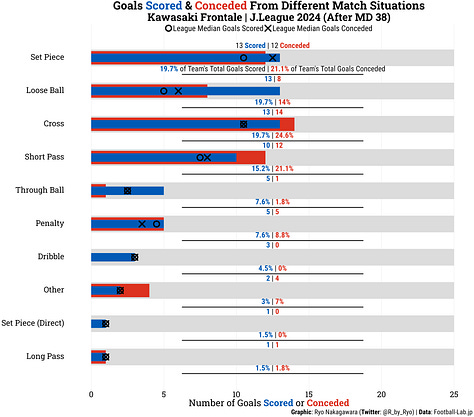
Yokohama F. Marinos (9th, 52 Points)
15 Wins // 7 Draws // 16 Losses
Location // Stadium: Yokohama // Nissan Stadium
Manager: Harry Kewell (Australia) // John Hutchinson (from August)
61 Goals (4th); 62 Conceded (17th)
57.62 xG (4th); 51.6 xGA (15th)
Top goal scorer: Anderson Lopes (18 goals plus 6 penalties)
Goalkeeper: William Popp
Well, Harry Kewell finally left the club after many months of horrendous performances and sideline antics against the referees. John Hutchinson didn't fare much better with some infamous shellackings by Gwangju and Sanfrecce Hiroshima opening up new scars in a beleaguered Marinos side. The one major defense I have of both managers is that Marinos were put into a very difficult position in regards to their playing schedule and it would’ve been extremely hard to find the time to do a lot of tactical planning/re-planning with the games coming thick-and-fast throughout the season.


A huge pivot needs to be made in tweaking their possession play principles with some actual defensive strategy. The risks were far outweighing the reward with their play style. The one good thing Hutchinson did was to revert Marinos to a double-pivot, instead of the single-pivot that Kewell used, which did alleviate some of the issues. Nevertheless, Marinos continued to be extremely poor in defensive transitions as they weren’t compact enough, which hampered individual player’s decision making ability to stem the tide of opponent attacks.

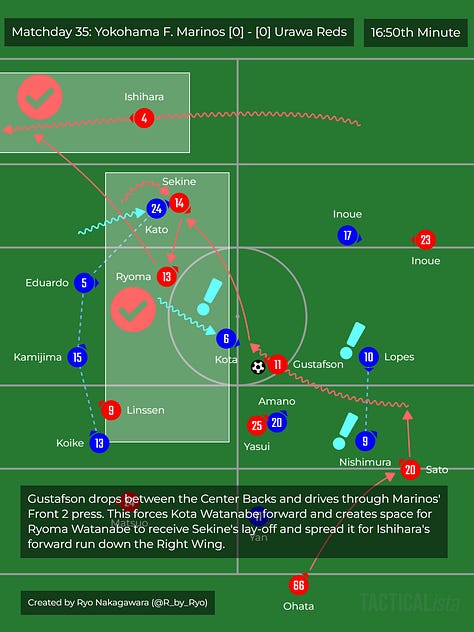

Of course, this will mostly be on the new manager to investigate, whoever it is. Marinos were saved from any relegation worries as their Brazilian attacking trio were still excellent but they are slowly getting older. Anderson Lopes had another fantastic season up top, finishing as the league’s leading goal scorer with 24 goals (6 were penalties). Elber curiously stopped taking a whole lot of shots even if he remained a threat with his passing and dribbling. It does look like Yan Matheus is taking up Elber’s mantle as the key winger in this Marinos side as the 25 year old finished with 5 goals and 8 assists. I will also add that Marinos seemed very reluctant to give the trio a rest despite alternatives on the bench. As results continued to worsen, the team stuck by the trio even more, which exhausted them further, and results continued to worsen, etc…
Meanwhile Ryo Miyaichi continued to suffer from injury issues and it really looked like Kota Mizunuma was on his last legs. Asahi Uenaka didn’t quite live up to the hype as he struggled to earn consistent starts although he was involved quite a bit from the bench. In similar vein, Kenta Inoue is another who will have question marks over his future as his move from Oita Trinita a few years ago hasn’t panned out.
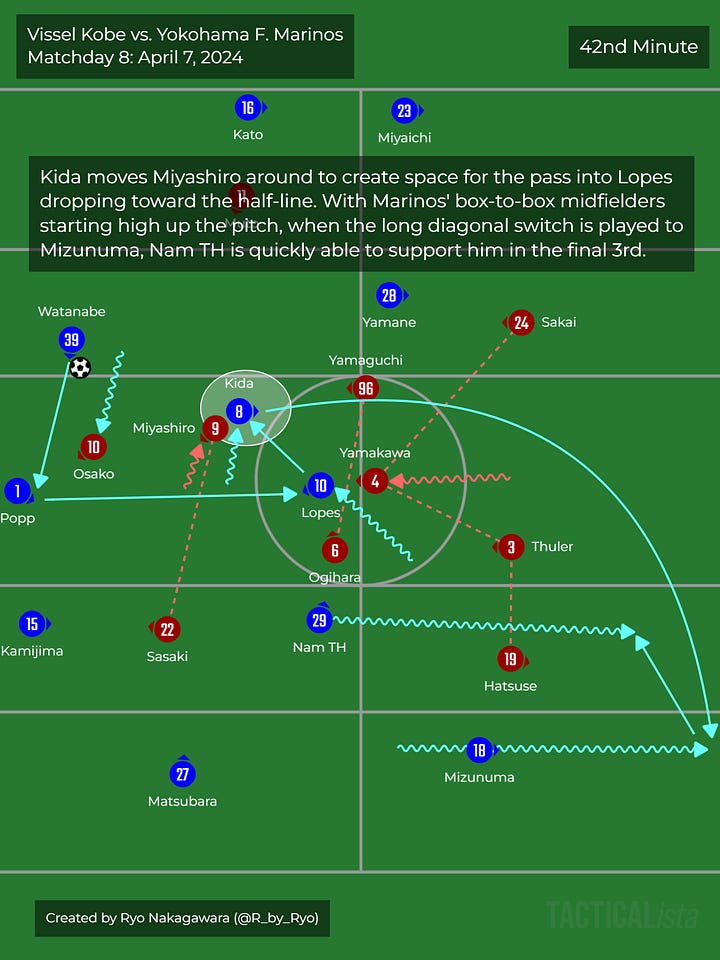


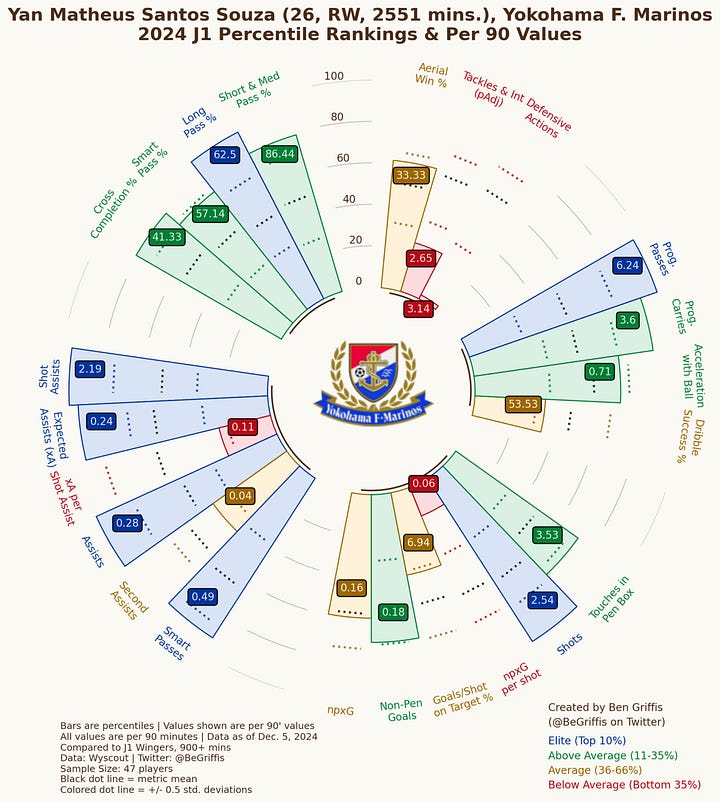
The midfield was really missing the leadership of captain Takuya Kida in the latter stages of the season. Kota Watanabe was paired with a bunch of different players to not optimal effect. On the other hand, Jun Amano returned to Marinos this year and it’s like he never left, playing a somewhat deeper role than he used to by sitting in the double pivot. I’ve liked him for a while and was disappointed when he moved to the K.League. Amano finished the season with a very good 5 goals and 5 assists.
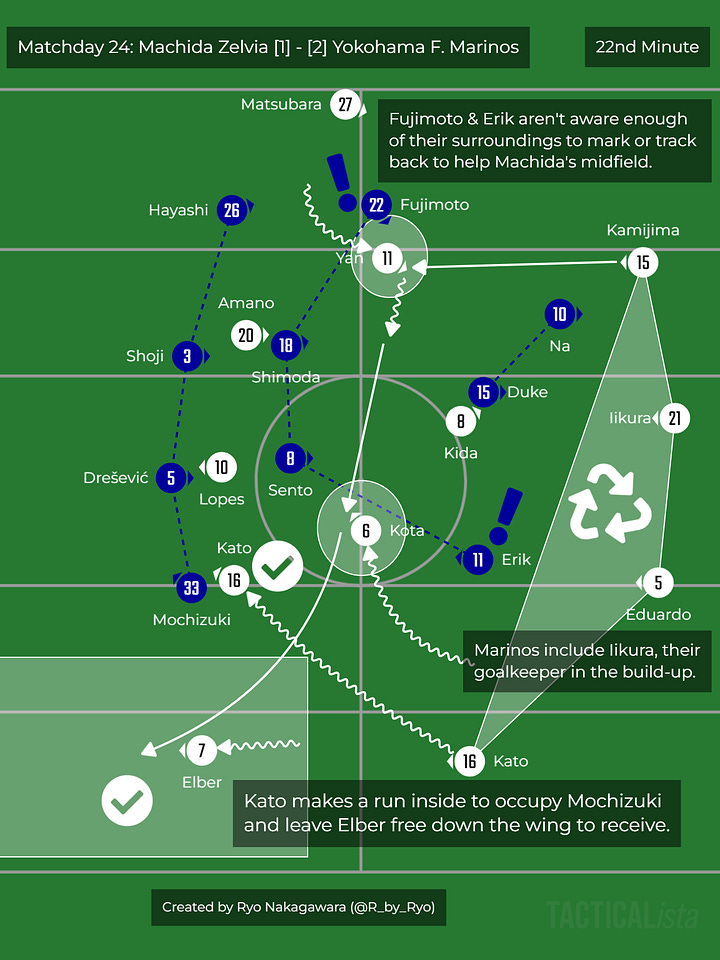



Rumors are swilling around Takumi Kamijima and Eduardo both leaving the club as Marinos seem to want to completely overhaul the back-line. This makes sense as although it’s a bit harsh to blame these players individually when it’s clearly a systemic issue, they didn’t exactly cover themselves in glory either. I was really confused on Kamijima’s signing initially but it’s weird they might be letting him go just as he was getting used to the “Marinos Way”? This is all still rumors and speculation of course…
NOTE: It’s been confirmed that Takumi Kamijima has moved to Avispa Fukuoka.
It’s difficult to rate the Full Backs considering there were so many injuries and turnover in the line-up aside from a relatively healthy Ken Matsubara. One player they were missing quite a bit was Ryuta Koike, who on his return in the summer~autumn was forced to play in central midfield due to other injuries in the squad. He’s a player I really like and it’s a shame we couldn’t see him in the Asian Champions League final this season. On top of the defense, I’m not a huge fan of William Popp but I can’t imagine they’ll change him out to when there’s probably going to be so much upheaval across the rest of the squad this winter. Veteran Hiroki Iikura stepped in a few times when Popp was injured while poor youngster Riku Terakado was given a baptism of fire as his professional debut was in the 3-7 walloping by Gwangju FC.
A new manager and an overhaul of the squad are absolutely vital over the holiday season as the core that led Marinos to lots of success are visibly aging. There are some huge market moves needed to be made this winter to address the huge shortcomings in the squad. While Marinos’ successes have come from adamantly and stubbornly playing their way of football, in recent times it’s become a concern that they struggle to adapt to their opponent’s gameplan. It might simply be a sign of the shifting tactical environment in the J.League as well…
Other data viz:





Cerezo Osaka (10th, 52 points)
13 Wins // 13 Draws // 12 Losses
Location // Stadium: Osaka // Yanmar Stadium
Manager: Akio Kogiku
43 Goals (16th); 48 Conceded (9th)
50.91 xG (5th); 46.1 xGA (12th)
Top goal scorer: Leo Ceara (16 goals plus 5 penalties)
Goalkeeper: Kim J.H.
Akio Kogiku, after nearly 30 years (!!!) at the club in various positions (around 3.5 years as the main manager), left Cerezo Osaka by mutual consent at the end of the season. He's tried a lot of different things and has had a lot of investment in the squad but he could never quite get things clicking consistently to really challenge for the title, let alone the ACL positions.


There was the “Kagawa as a regista” experiment last season, the 3-2 build-up with Noborizato inverted earlier this season which earned a lot of plaudits and was a huge factor in Cerezo's excellent start to the season where they didn't lose a single game until Matchday 9, and near the end of this season Kogiku shifted to a Back 3 plus Wing Backs. Cerezo had good build-up play and can get from the Defensive 3rd to the Mid and Final 3rd but really lacked any ideas in terms of chance creation besides some inspiration from Lucas and then very good finishing from a variety of situations by Leo Ceara.

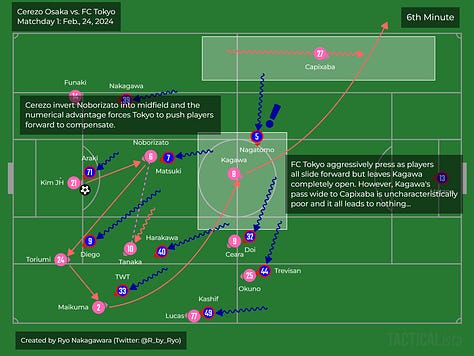

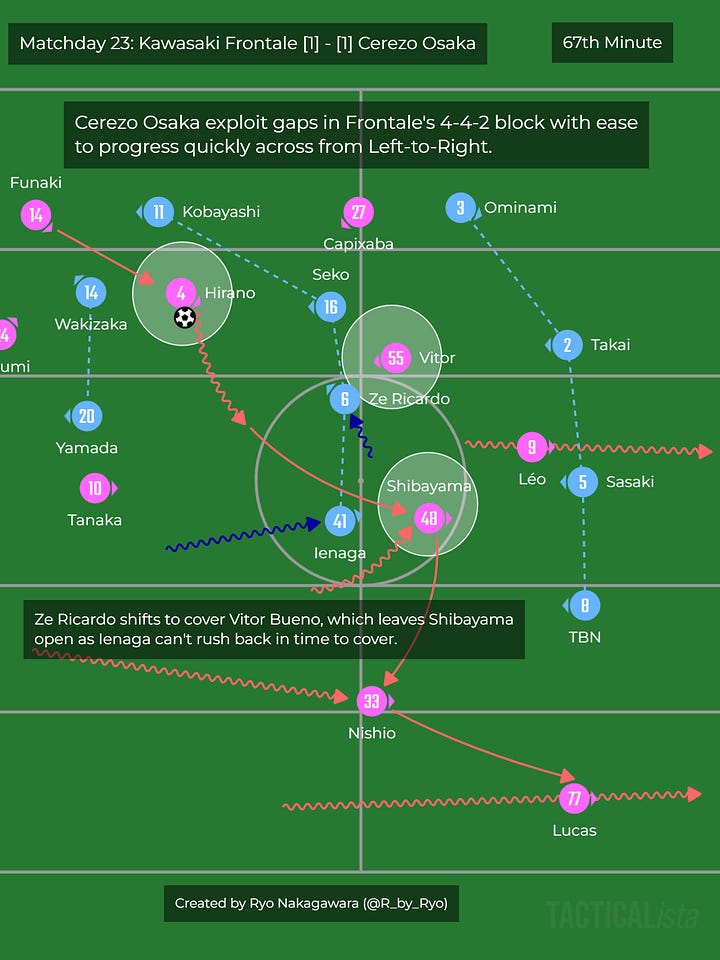
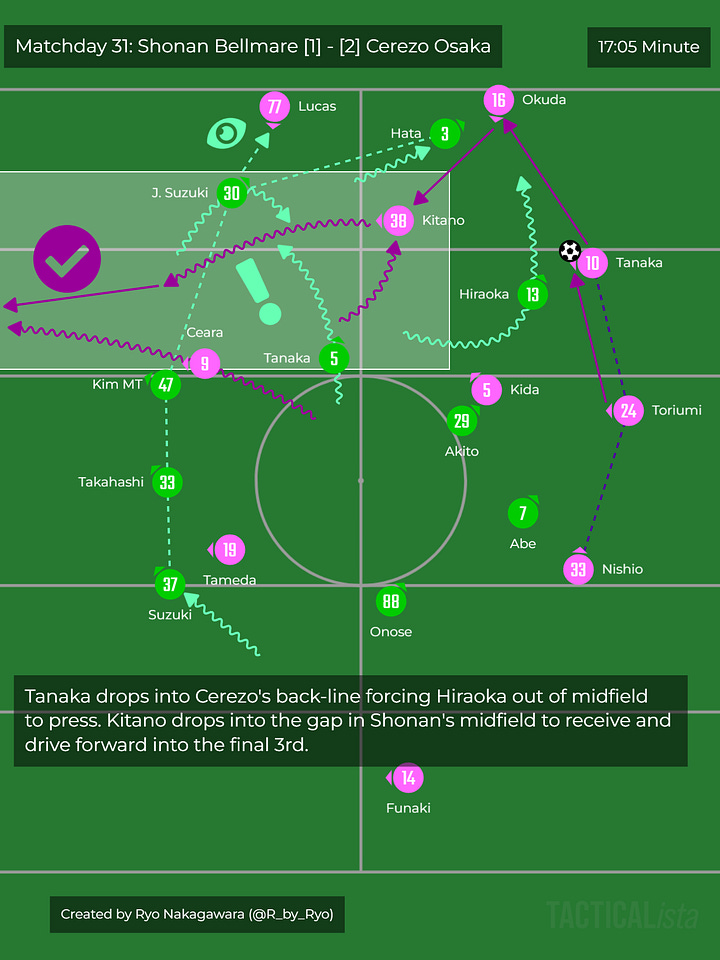
They still only really scored from set-pieces or crosses, and even then it wasn’t to such a degree that they were better at those situations than the rest of the league.
It was a bit worrysome just how skewed the chance creation on Cerezo was pretty much all funneled toward Leo Ceara, even if you account for the fact that Ceara had 7 penalty opportunities (of which the Brazilian only scored 5). Ceara’s 23.05 xG (resulting in 21 goals) was higher than the xG accumulated by the next nine Cerezo players… combined!
Leo Ceara and Lucas with Vitor Bueno and Capixaba sometimes pitching in, I don’t think it’s an unrealistic expectation to have to simply expect a lot more from Cerezo with the attacking talent they have. Further behind them, Shunta Tanaka aspired to be a midfielder and his wish was granted (it’s one of the reasons he moved to Cerezo from Sapporo). He was fairly solid and even pitched in with 3 goals and 4 assists but is he really that good enough to build your entire team around? I still am absolutely perplexed they got rid of Tokuma Suzuki and to their cross-town rivals Gamba Osaka no less!
A positive that appeared in the last few months of the season was Sota Kitano, who played as a #10 and looked somewhat decent. Speaking to the future, there are a few loanees out in J2 like Jun Nishikawa and Rui Osako (both Iwaki FC) that might be interesting for the new manager to integrate next season as well. I really do think Cerezo's defense is where they need to look at for reinforcements as I discussed earlier in the season (on a lot of different social media) that Funaki, Toriumi, Nishio, Shindo is not a very good defense in front of a largely still-good (but not perfect...) Kim Jin-Hyeon. Reiya Sakata and Hayato Okuda are also interesting prospects that can improve but they need better veteran leaders around them to excel.


It was very rare to see Cerezo score multiple goals and that’s not a good thing when the defense was as flimsy as theirs. There’s definitely a good squad here for the new manager (whoever it is) but they are really missing that extra bit of something. Both in terms of personnel but also tactically to get more out of their really good attackers.
Other data viz:

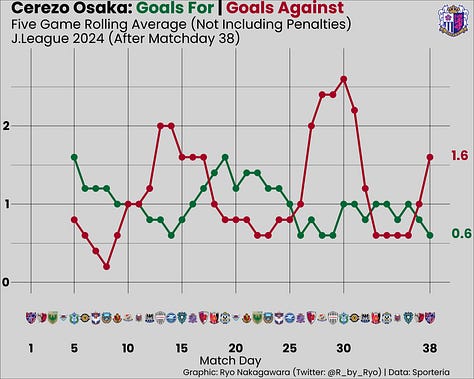



Nagoya Grampus (11th, 50 points)
15 Wins // 5 Draws // 18 Losses
Location // Stadium: Nagoya // Toyota Stadium
Manager: Kenta Hasegawa
44 Goals (tied 14th); 47 Conceded (8th)
39.5 xG (17th); 42.96 xGA (7th)
Top goal scorer: Kensuke Nagai & Sho Inagaki (6 goals, 5 goals plus 1 penalty)
Goalkeeper: Mitch Langerak
Nagoya Grampus had another very mixed season, very poor in the league yet a League Cup triumph! From a tactical perspective, when Hasegawa’s master plan to nullify the opponent works, Grampus don’t concede and they stump the opponent’s possession play… but Nagoya usually don’t actually look like they are able to score themselves no matter what the plan or opponent is! All-in-all, most Nagoya games turned into a very turgid affairs where neither the opponent nor Nagoya themselves created many chances…
Kenedyegbus Mikuni isn't a bad defender, in fact he can be quite good a lot of the time. Decently quick, strong, and good awareness but I don’t think he's very good with his feet and poor passes led to a lot of dangerous chances (and worse, goals) conceded. I think his performances throughout this season showed why he was never in contention for a regular spot at Avispa Fukuoka these past few years. It doesn't help that the two times this season that I saw him live at the stadium were probably his worst performances (Kawasaki Frontale & FC Tokyo) but watching Nagoya's other games showed that I'm not nearly as harsh as I could've been. Still, this was his first professional season as an actual J1 regular so I’m sure there’s room for improvement next season.
A big question mark for me was Ha Chang Rae inexplicably being left on the bench while Takuya Uchida kept playing as a Center Back. Uchida is at best an okay J1 level player, but he is a midfielder first and foremost. At worst you play him at Wing Back because he works hard so seeing him at Center Back for most of the season was just mind boggling to me. This was especially so when the guy on the opposite side of the Back 3 was someone like Akinari Kawazura who was just a recipe for a bad time, no matter how well Mikuni, Nogami, or Ha Chang-Rae played. I mean, there’s only so much Mitch Langerak can do (I might sound blasphemous but I also feel that Langerak has been on the decline in the past two or so years…).


In midfield, it was clear that Takuji Yonemoto was finally aging out so him moving on made a lot of sense. Keiya Shiihashi and Sho Inagaki as the double pivot were a very hard-working “functional” unit but hardly creative despite Inagaki’s willingness to make good runs in the final 3rd (especially with his 6 goals and 2 assists). The few experiments of dropping Tsukasa Morishima down a line in there never quite stuck. I was quite excited to see the arrival of Taichi Kikuchi but either he’s barely played minutes or when he has, he was shunted to Wing Back! Again, what is going on?!
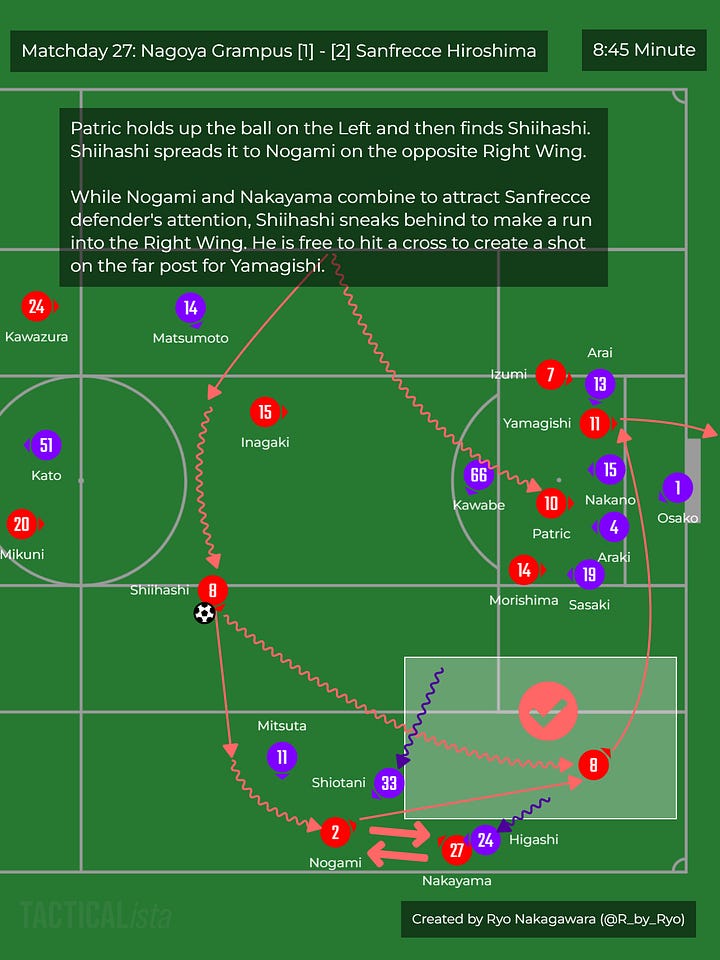
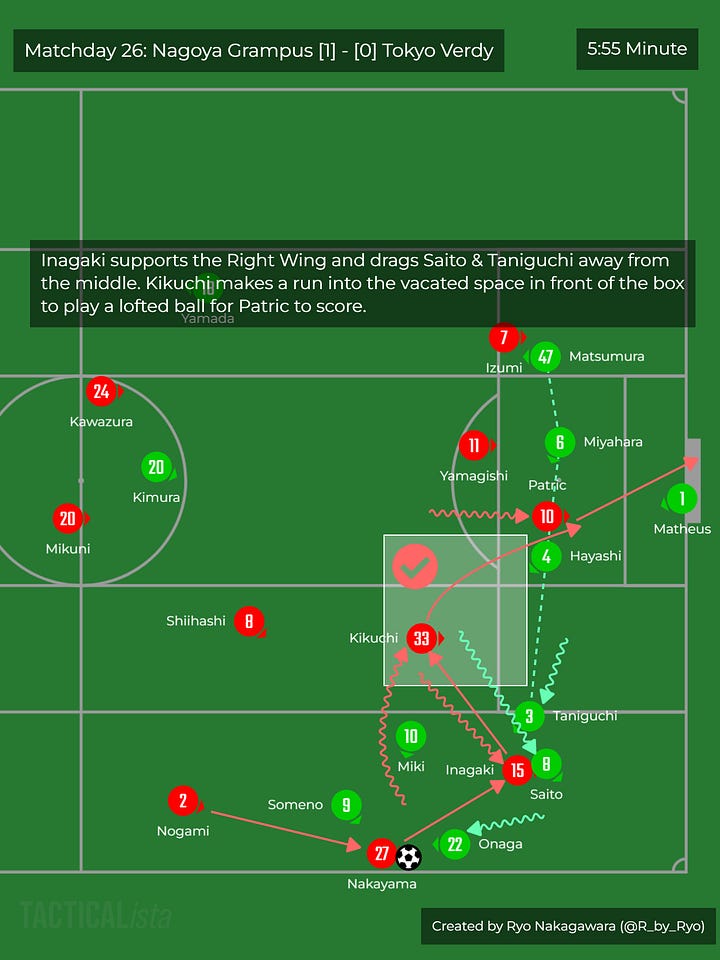
A big problem was up front and scoring goals in general. Of course, it didn’t help that “Plan A” in the form of Kasper Junker just wasn’t able to keep himself fit. Just the 7 starts, 19 appearances, all totalling up to 8.5 90s for the Danish striker who still managed to conjure up 4 goals and 1 assist in that meager time! Yuya Yamagishi also had his injury issues which exacerbated Grampus’ issues up front but his paltry 1 goal and 1 assist was still rather disappointing. Instead, Kenta Hasegawa has had to rely on some old workhorses like Kensuke Nagai and Patric. Nagoya also had to rely a lot on set-pieces, their 16 goals from these situations amounted to a whopping 36.4% of the teams total!
It was also announced in late November that Kenta Hasegawa’s contract was renewed for the 2025 season. I am very skeptical about this decision. It’s been three (3) whole years under Kenta Hasegawa and while sure, they won the league cup this season but in the league they haven't progressed much at all! For a manager that claims that he usually needs a season to figure things out and then really push up the table, he’s had multiple poor mid-table finishes all the while playing some absolutely turgid football. Nagoya took the least amount of shots in the league, even fewer than notoriously attack-shy Avispa Fukuoka. One could say that the shots they did take were fairly decent as their xG per shot was the 4th best in the league but the fact of that matter is that they simply didn’t rack up a whole lot of xG in total either, just the 39.5 xG which was 4th worst in J1…
A bittersweet note is that Mitch Langerak is returning home to Australia after 7 years in the J.League. Whatever my thoughts on Nagoya this season, I am glad he was able to win another trophy before he left. However, after losing Haruya Fujii and Shinnosuke Nakatani last season, now Hasegawa has to cope with the loss of one of the league’s better goalkeepers as well as trying to make moves in the market to rectify the oldest squad in the league! It’s also the oldest in terms of the average age of the players who played 50% or more league minutes. Busy months ahead for Nagoya Grampus!
Other data viz:





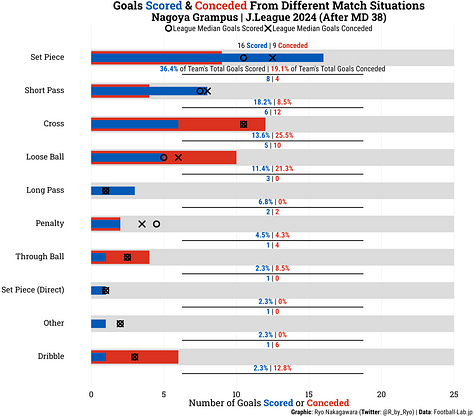
Avispa Fukuoka (12th, 50 points)
12 Wins // 14 Draws // 12 Losses
Location // Stadium: Fukuoka // Best Denki Stadium
Manager: Shigetoshi Hasebe
33 Goals (20th); 38 Conceded (4th)
32.64 xG (20th); 42.52 xGA (6th)
Top goal scorer: Shahab Zahedi (8 goals plus 1 penalty)
Goalkeeper: Masaaki Murakami / Takumi Nagaishi
The big news was that Shigetoshi Hasebe left the club at the end of the season. There’s honestly not a whole lot to talk about that I haven’t already done in previous season reviews for Avispa Fukuoka. Perhaps that’s part of the problem? It’s clear to all interested parties that Hasebe has taken them as far as he could so the decision for Hasebe to leave for a new challenge/Avispa to let him go makes a lot of sense in my opinion. There’s a clear ceiling with the talent available and what a club like Avispa can afford in the future as well which would’ve factored into Hasebe’s decision.
In midfield, Hiroyuki Mae continued to be the heartbeat of this side as ever, on and off-the-ball. Kazuya Konno continued his good form as one of the few creative sparks in the team adding a career best 6 goals on top of 2 assists (he was one of the players that has quickly extended his contract for next season so Avispa fans can breathe a bit easier).
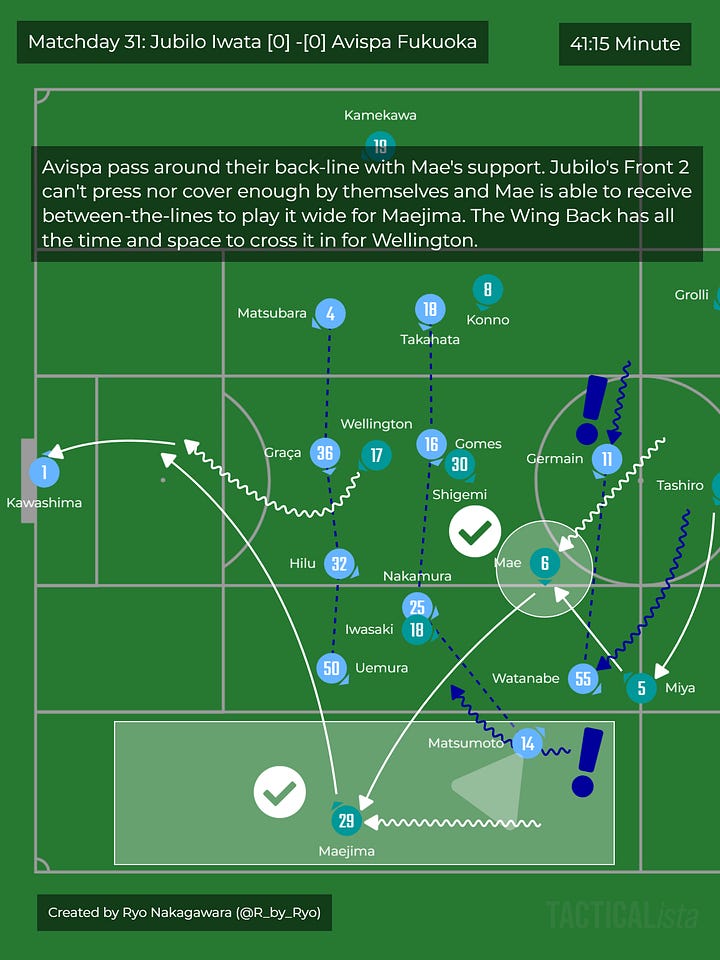



In defense, the man-mountains (men-mountain?) of Douglas Grolli, Daiki Miya, Masaya Tashiro, among others stood tall and were once again a part of one of the best J.League defenses. Many will send well wishes to Takumi Nagaishi who did suffer a somewhat serious cranial injury in November and will be out for a number of months. It’s unfortunate timing as he had just re-won the starting spot off Masaaki Murakami in Avispa’s endless goalkeeping tug-of-war over the past few months.





Unfortunately, as has been the case under Shigetoshi Hasebe’s tenure, Avispa’s attack was abysmal once again. Third least final 3rd entries, second least opposition box entries, second fewest shots taken, second fewest shots on target, the least total non-penalty xG, all leading to the least goals scored. Throughout the season Avispa had to rely on their rock solid defense and then for little flickers of inspiration from their attackers. One such attacker was Shahab Zahedi, who made a huge impact at the start of the season but faded as the Iranian didn’t net another goal after early August. His battle with Wellington for the starting striker spot was quite interesting to track throughout the season. The Iranian nonetheless finished the season as Avispa’s top scorer with 9 goals from 7.07 xG and some of his goals were truly jaw-dropping stuff!
Avispa have established a decent foothold in J1 right now and they’ll want to keep it as the league transitions to the fall-spring season in 2026. One thing that has been a huge discussion point among J.League fans is whether Avispa want to continue this bunker-down-and-defend style or if they want to switch to a more expansive style of play. This is a big turning point for Avispa as they absolutely need to get this next appointment right, whatever the flavor of football it might be.
NOTE: Kim Myung-Hwi has been appointed as Avispa Fukuoka’s new manager.
Other data viz:






Urawa Reds (13th, 48 points)
12 Wins // 12 Draws // 14 Losses
Location // Stadium: Urawa // Saitama Stadium
Manager: Per-Mathias Høgmo (Norway) // Maciej Skorza (from August)
49 Goals (11th); 45 Conceded (7th)
46.01 xG (10th); 43.08 xGA (8th)
Top goal scorer: Thiago Santana (8 goals plus 4 penalties)
Goalkeeper: Shusaku Nishikawa
Høgmo was Hognomore... and somehow Maciej Skorza returned. It’s now been 3 different managers over the past 3 years, 4 if you count Skorza returning as a separate distinct manager (and to be honest I think it should be). As you can tell, Urawa were an absolute mess this season. Maciej Skorza came back to a squad where his core spine of Hiroki Sakai, Alex Scholz, Ken Iwao, Atsuki Ito, and Jose Kante from the 2023 were all gone so he was dealing with a very different squad. Although there were relegation scares in the final months of the season (mostly due to Urawa’s games-in-hand), I really don’t think they were ever in a position to be actually relegated. As a lot of Urawa’s stats showed, they were simply in mid-table mediocrity throughout the season and nowhere near the worst teams.


Nevertheless, the Polish manager (re)inherited a squad that "on paper" should still be quite good, given the amount of investment, but it is oddly balanced. You look at Urawa's bench on a lot of match days in the past few months of the season, it was bare-bones and there was usually no extra Center Back or Full Back OR Central Midfielders on the bench, instead it's all the millions of attackers that they've brought in over the past year! Even when you account for injuries, it’s just clearly not optimal. Even worse is that a lot of the attackers were completely anonymous or couldn't seem to stay fit at all!
With Ken Iwao and Atsuki Ito leaving, Urawa were down to just Sam Gustafson and Kaito Yasui as actual central midfielders (and Yasui has always been more of a #8 or #10 to me anyway), to the point where they had to suddenly convert Genki Haraguchi to the double-pivot as soon as he made his return to Urawa in the summer after Gustafson got injured. This also didn’t help Kaito Yasui who seemed pretty overworked to me! On the other hand, Hirokazu Ishihara and Ayumu Ohata were fine, if not quite good actually. At the very least Urawa won't have to worry about that position for the medium-to-long term even though they do have to force Takahiro Sekine or Yuichi Naganuma to provide cover.
It was really difficult for Skorza to (re)set up his style of play under many injuries and weird schedule changes due to the weather. He hasn’t had the time yet to recreate the chemistry between players and having that understanding for his particular out-of-possession structure that proved very successful in 2023 as one of the league’s best defenses. I think if you squint closely or watched a lot of Urawa back in 2023, you can see some semblance of that previous team’s tactics in the last few months of 2024 but it’s still very much a work-in-progress.

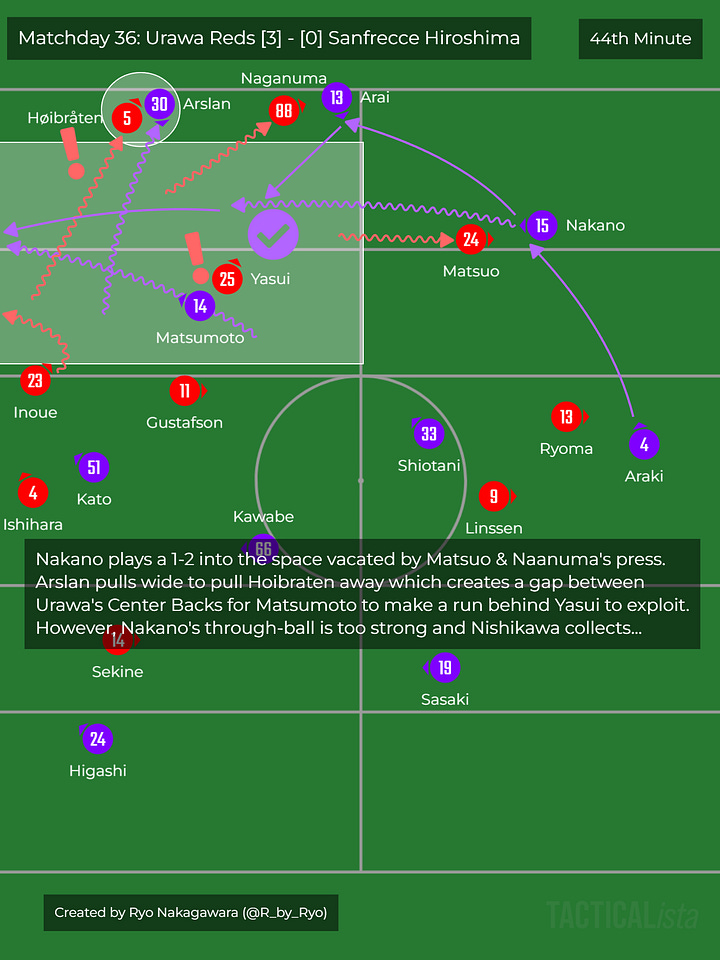


In attack, Skorza set Urawa up to be far more direct than his predecessor with the Full Backs providing the width, while attacking midfielders and strikers are squeeze centrally to create quick combination plays to get behind the opponent’s defense line. Both under Høgmo & Skorza, Sam Gustafson was the midfield fulcrum as most, if not nearly all of Urawa’s ball progression and good possession sequences came through the Swede’s silky soccer skills. He was genuinely very good when he wasn’t injured and even contributed with 2 goals and 3 assists despite being the deepest-lying midfielder.
Ryoma Watanabe was forced to spend a good chunk of the season as a Left Back. However, thankfully, as the season has wore on he returned to playing further forward where he belongs and has been one of Urawa's few bright sparks throughout the season. Since his FC Tokyo days he has always stood out not just for his creativity but his work-rate as well in terms of getting into good positions and making runs on both sides of the ball. Yusuke Matsuo’s return was like an injection of hope for this ailing side. It was like he never left as he was an absolute menace down the Left flank with his tireless off-ball runs and mazy dribbles.


Urawa have had a huge problem at striker over the past few seasons but to be honest, I can't really blame them individually considering all the issues in the rest of the squad. Bryan Linssen never quite got into any sort of goal scoring form (despite his other merits) and it was announced that he’s leaving the club this winter anyway. Meanwhile, this season’s attempt in the form of Thiago Santana was… OK with 8 goals plus 3 penalties. I think a lot of people were expecting a lot more from him though so we’ll see how he does next season.
The Club World Cup is looming ever closer, coming up in the summer of 2025. Much like Skorza’s first stint where he had to quickly cobble up the pieces to get Urawa ready for a big Asian Champions League final vs. Al-Hilal, the Pole will need to rustle up all of his managerial skills to get Urawa firing on all cylinders from the start of the 2025 season. A big task for the manager and the recruitment team await in the coming months to re-organize an awkwardly balanced squad.
Other data viz:


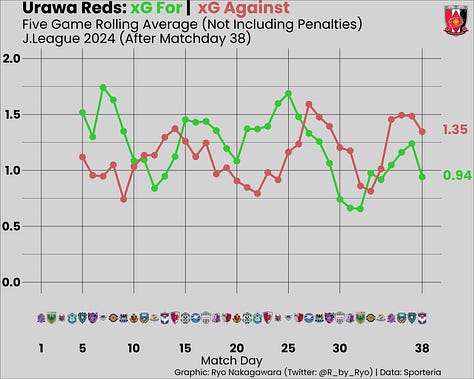



Kyoto Sanga (14th, 47 points)
12 Wins / 11 Draws // 15 Losses
Location // Stadium: Kyoto // Sanga Stadium
Manager: Cho Kwi-jae (South Korea)
43 Goals (tied 16th); 55 Conceded (13th)
46.68 xG (8th); 55.37 xGA (18th)
Top goal scorer: Rafael Elias (10 goals plus 1 penalty)
Goalkeeper: Gu S.Y.
Kyoto Sanga survive J1 once again despite sitting in 19th at the halfway point of the season. The story of their season has been Rafael Elias who transformed into Ronaldo Fenomeno with 11 goals in 12 starts from 7.4 xG! All from signing on-loan in July! We could also just say the Brazilian was this season’s version of Taichi Hara.
Basically the 2nd half of the season turned into:
1. Continue the high press even when it doesn't really work.
2. Give the ball to Elias, Hara, Tulio on the counterattack.
3. ???
4. Sometimes score goals and get a result?


I still think Kyoto are not good and things might take another turn for the worse next season once Elias' hot form in front of goal dissipates but well, it's kept them in J1 this time so ... mission accomplished?! One of these years Kyoto’s whole "let's buy a striker in the summer and hope we hit the jackpot!" strategy is definitely NOT going to work especially paired with Cho Kwi-jea’s continued insistence on a high press/counterpress that's not actually very successful...
Sota Kawasaki has played in a more box-to-box role in recent seasons compared to when he first broke out as a single pivot. He continues to be very involved at either end of the pitch with 3 goals and 1 assist to his name. Shinnosuke Fukuda was another player to watch, indefatigable with constant runs up-and-down the pitch and whipping in tons of crosses. A not insignificant source of goals was also Taiki Hirato’s set pieces in a breakout year for the midfielder who finally established himself as a starter at the J1 level with 2 goals and 6 assists this season.
One could say Taichi Hara only scored one more goal compared to the brilliant half-season in 2023 but he’s taken it upon himself to do a little bit of everything for this team. He helps out defensively, is very good in the air, drives forward with the ball or makes sacrificial runs to create space for teammates, a lot of good effort. 8 goals and 2 assists was still a very good return for a consistently relegation-threatened team!


So all-in-all I feel like this team has a lot of fantastic individual performances but the teamwork and 2010s Bundesliga pressing style just seems stale. They thrive on chaos that make for wacky games like against Sagan Tosu or Yokohama F. Marinos. They seem to play better when they’re a man down because of all the space their opponents open up for them to counterattack into! In stark contrast, Kyoto are quite horrible when they are given the ball, they just have no idea what to do with it. A fun exercise: go to Kyoto Sanga’s FBref page, scroll down to “Scores & Fixtures” section and sort the match results by possession rate, it’s quite illuminating!
Ultimately, manager Cho Kwi-jae has been confirmed to be staying on for 2025. I can’t imagine the manager changing up his tactics much so the transfer guys are going to have to do a lot of heavy lifting to simply buy good players and hope things work out.
Other data viz:







Shonan Bellmare (15th, 45 points)
12 Wins // 9 Draws // 17 Losses
Location // Stadium: Shonan // Lemon Gas Stadium Hiratsuka
Manager: Satoshi Yamaguchi
53 Goals (7th); 58 Conceded (15th)
46.92 xG (7th); 51.42 xGA (14th)
Top goal scorer: Lukian (10 goals plus 1 penalty)
Goalkeeper: Song B.K. // Daiki Tomii
Another year, another season where Shonan Bellmare pulled themselves together in the last few months of the season to survive the drop! I feel that this young squad was actually quite decent and they really shouldn’t have had to scramble at the end of the season every time but with lots of turn-over every off-season I suppose it makes sense that it usually takes sometime for manager Satoshi Yamaguchi to figure out his best line-up.


Early season attempts at a 4-4-2 shape didn’t pan out and Shonan switched back to their tried-and-tested 3-5-2 shape pretty early on. Regardless of the formation, it was business-as-usual in terms of being very aggressive in the press from start-to-finish. However, when opponents were able to get past that initial press things could be pretty porous at the back. In addition, a notable weakness was Shonan’s set piece defending which is how they shipped 16 goals (nearly 30% of their total)!



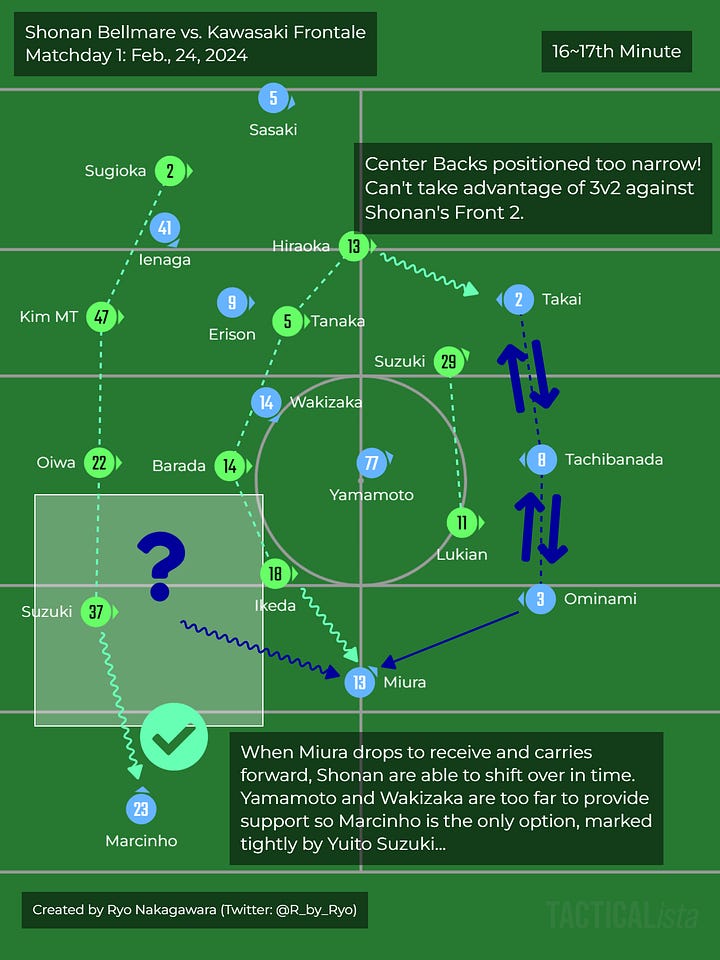
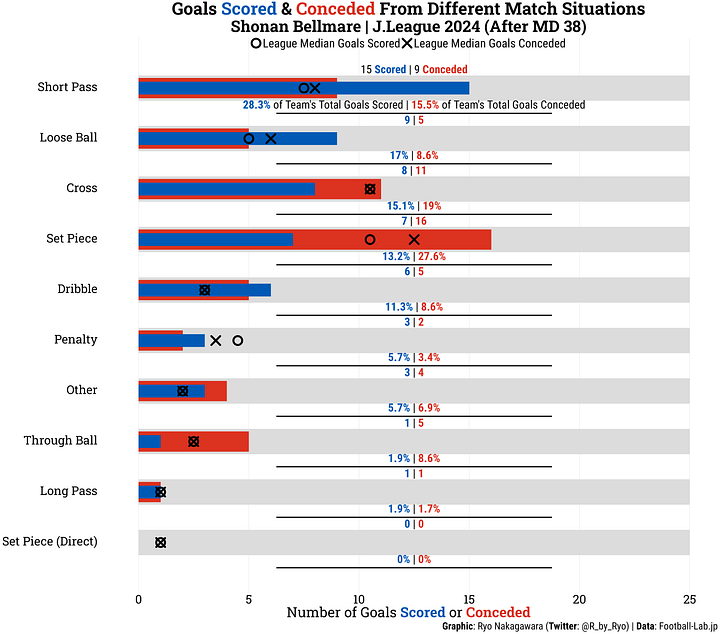
A young player that stood out to me in defense was Junnosuke Suzuki who won a spot in the starting XI in the second half of the season. He played on the Left of the Back 3 and is very calm on the ball with very good ball-carrying and passing abilities (especially long balls). His integration into the team has been seamless to the point that Shonan have not missed Daiki Sugioka at all who was plucked away by Machida Zelvia during the summer. Since his return from (yet another) injury Taiga Hata made a huge difference to Shonan. His presence alone added a lot more dynamism to their attack from the Left that had been slightly slanted toward Yuto Suzuki's Right side for most of the season. Darting, powerful runs that really penetrate defenses!


A long time favorite of this newsletter, Satoshi Tanaka, slowly shook off the disappointment of returning to Japan last summer to great effect. He has added a lot more attacking to his game with 4 goals and 4 assists while still maintaining his great ball winning/recovering abilities. I would really like to see him get another chance at Europe again.



Akito Suzuki, while he probably won’t make a move this winter as I think it’s still too soon, is one to watch next season as he’s shown more than a few bright moments in 2024. He finished the season on a very good 10 goals from 8.76 xG and 1 assist. Akito’s partner-in-crime was usually Sho Fukuda who had a breakout season with 10 goals from 7.62 xG and 4 assists in his first full season at the J1 level since arriving in the summer of 2023. It’s actually quite incredible how well he’s stepped up as Fukuda skipped J2 entirely by jumping from J3 with YSCC Yokohama before finishing the 2023 J1 season goal-less. It’s clear that half-season in 2023 was good acclimatization as he was able to figure out what was required at the J1 level to excel in 2024.



As mentioned, Shonan found fantastic form when it mattered in the tail-end of the season with 9 wins in the 2nd Half of the season compared to just 3 in the 1st Half. One wonders where they could finish if they were able to maintain this form from the beginning of a season... A big problem as per usual is the “Shonan Gap” in their squad profile. They just can’t afford to keep a hold of good “peak age” players as other J.League teams (or overseas clubs) are constantly hovering around like vultures so they have a lot of either really young players or really old players! It’s always fun to see Shonan’s mix of youth and experience but another turbulent transfer season awaits…
Other data viz:




Albirex Niigata (16th, 42 Points)
10 Wins // 12 Draws // 16 Losses
Location // Stadium: Niigata // Denka Big Swan Stadium
Manager: Rikizo Matsuhashi
44 Goals (14th); 59 Conceded (16th)
43.82 xG (12th); 45.15 xGA (10th)
Top goal scorer: Kaito Taniguchi (10 goals)
Goalkeeper: Ryosuke Kojima
Rikizo Matsuhashi built upon the foundations by Albert Puig, for whom he was an assistant coach and got Niigata promoted in his first ever season as a manager as the J2 winners of the 2022 season and followed that up with a comfortable 10th placed finish in their return to J1 in 2023. The coup-de-grace could've been Niigata's first ever cup title but it wasn't to be as they were defeated by Nagoya Grampus in the League Cup final last month on penalties after extra time in a scintillating affair. Unfortunately, their league form plumetted with their last win of the campaign was all the way back in mid-September on matchday 30.
Niigata play a very heavily possession based football and take great care in building up from the back. All of their players from Goalkeeper to Striker are technically sound. Rikizo Matsuhashi has continued the legacy of the possession-based ideology from previous manager Albert Puig as well as incorporating lessons from his time under Ange Postecoglou's Marinos teams.
The formation is 4-2-3-1 with one of the double pivot often dropping into the back-line during the build-up phase. The other pivot remains to form a 3-1 build-up pattern while the Full Backs spread wide or invert slightly into the half-spaces. They can have their goalkeeper split the Center Backs as well to leave the midfielders as options higher up in the middle 3rd of the pitch. The Full Backs act as extra midfielders who can help quickly switch play from one side to another and then make underlapping runs to support the wingers receiving out wide. Center Backs are encouraged to keep circulating the ball under pressure and find vertical passes into the feet of midfielders behind the 1st line of press or to find attackers dropping deeper. Any of the central midfielders can drop into the back-line or be the lone pivot in front of the defense to act as the conduit to the rest of the attack. Their 56.6% average ball possession and passes per game were the second highest and highest in J1.
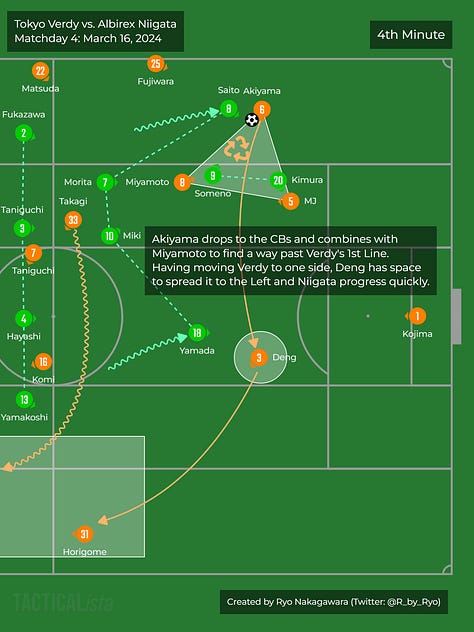

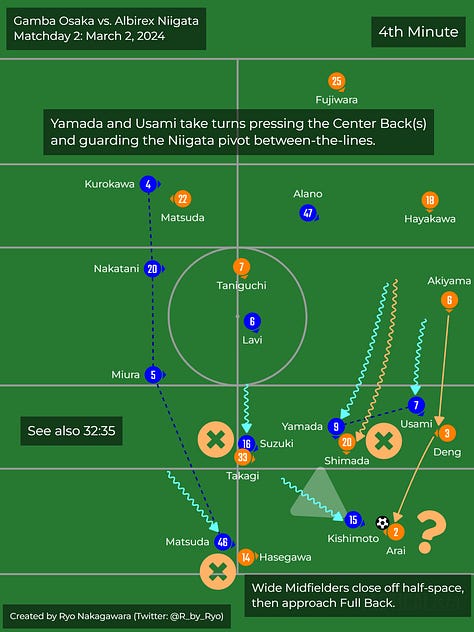
A big part of Niigata’s strengths in-and-out of possession was Ryosuke Kojima, their goalkeeper with good reflexes and comfortable with the ball at his feet. He’s got lots of experience throughout the youth national team setup but has yet to make his debut for the senior team. Kojima has courted a lot of interest, most notably from Urawa Reds so there could be movement in the future. Out on loan for the past few seasons has been Kazuki Fujita, currently on loan to JEF United in J2, to possibly take Kojima’s place.


My favorite player on Niigata is Hiroki Akiyama. A 23 year old central midfielder who has taken the baton as Niigata's orchestrator from midfield after the departure of Takahiro Koh to FC Tokyo before the season. A vital part of Niigata's build-up with his fantastic technique and clever positioning.
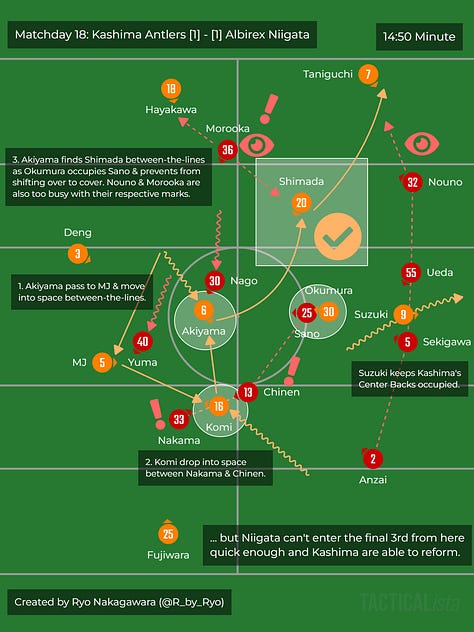

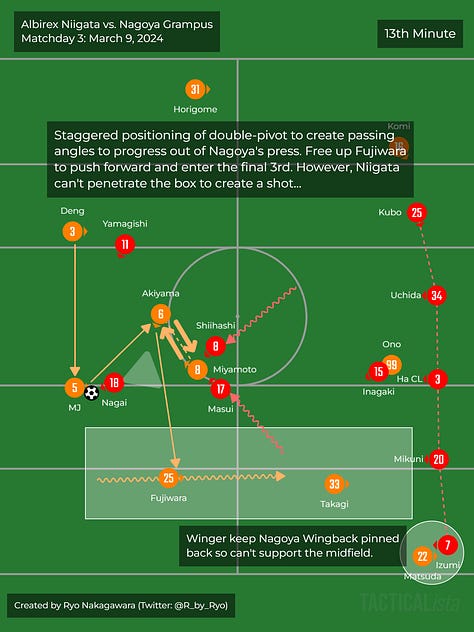

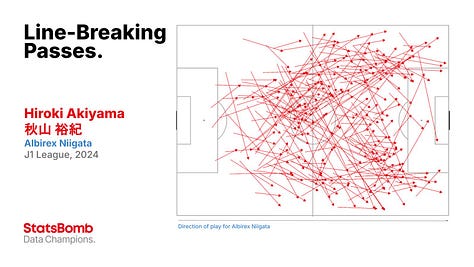

On the defensive side of things however, the high press wasn't great, it simply created lots of spaces between-the-lines for opponents to play passes through, which all resulted in Niigata getting pushed back into their own defensive 3rd quite a bit. If they can't push opponents back through their build-up play from deep, they really struggle as they get pinned back for long spells of the game. Despite the technical skills of the defenders, they still do get caught out at times and concede dangerous counterattacks as well.
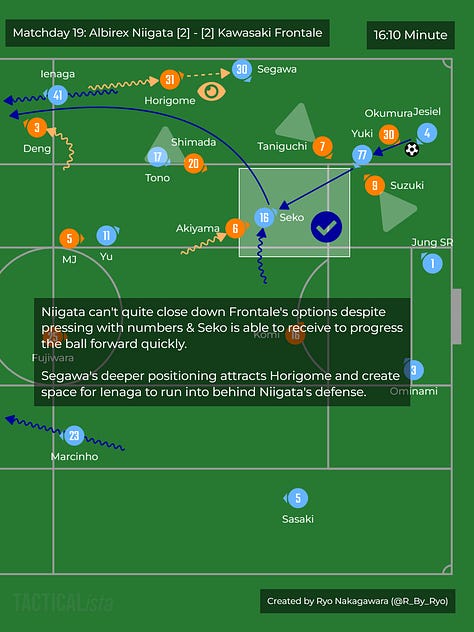




The defense has been held by two very old stalwarts in Michael James Fitzgerald (36 years old) and Kazuhiko Chiba (39 years old) from Niigata's J2 days. However, in the past year or so Australian Thomas Deng has slowly won his spot next to Michael James. Veteran Fumiya Hayakawa and new signing Ryo Endo occasionally filled in as well. Full Back used to be held down by Naoto Arai but he made a shock move to Sanfrecce Hiroshima right after the season started. Since then it has been Soya Fujiwara's position and Matsuhashi's trust has been rewarded with 4 goals and 2 assists from the Right Back. On the Left Yuto Horigome's form wavered and so during the summer, Kento Hashimoto was brought over from J2 side Tokushima Vortis and he was quite good.
Compared to the previous 2023 season, Niigata created more opportunities to get into the box and getting shots off but they were still struggling to consistently score goals as their 44 goals had them in 15th for "goals scored". In attack there are a lot of pieces that are rotated in/out depending on form. Yota Komi, Motoki Hasegawa, Yoshiaki Takagi, Danilo Gomes, Shusuke Ota, Eitaro Matsuda, and Kaito Taniguchi have all appeared out wide for various periods but never quite cementing their place in the side. Only Kaito Taniguchi has reached double digits with 10 goals… but from just 5.3 xG (21 starts and 31 total appearances). He loved to cut in from the Left Wing on his strong right foot and had a penchant for scoring some well-struck long-range scorcher golazos!


Tommy Deng has been let go in a surprise for me. Hayato Inamura (who impressed in short cameos in the league and the league cup) and I imagine quite a few other younger Center Back options will be coming in as Niigata have quite an old defense line without the Australian. Along with a number of players getting quite old, more than a few will be on the radars of other J1 clubs, and of course the search for a new manager, there will be a lot of upheaval at Albirex Niigata over the winter.
Other data viz:




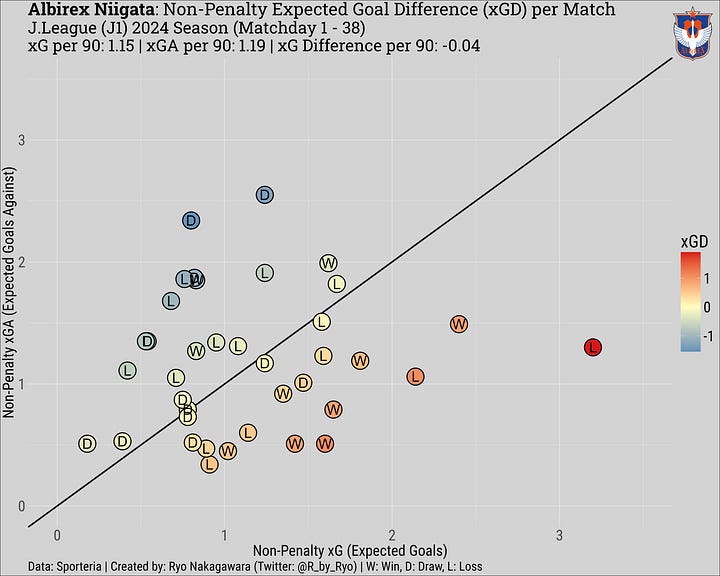
Kashiwa Reysol (17th, 41 points)
9 Wins // 14 Draws // 15 Losses
Location // Stadium: Kashiwa // Sankyo Frontier Kashiwa Stadium, “Hitachidai”
Manager: Masami Ihara
39 Goals (19th); 51 Conceded (12th)
49.44 xG (6th); 40.63 xGA (5th)
Top goal scorer: Kosuke Kinoshita (10 goals)
Goalkeeper: Kenta Matsumoto
Kashiwa Reysol just about survive relegation by the skin of their teeth. They had just the two wins since early July (matchday 22) but somehow they weren’t relegated as there were three whole teams that had even worse records in 2024! I can talk about tactics this or data that but at the end of the day, Reysol’s playstyle amounted to simply "Pass the ball to Matheus Savio and PRAY". He was the top or close to the top in terms of chances created, crosses, forward runs, etc. the man was a menace and he just didn’t stop! Savio’s defensive output was nothing to scoff at either. The Brazilian worked extremely hard off the ball and there should be no shortage of suitors once again during the winter off-season. He was rightfully included in the J.League’s Best XI of the season.




Kashiwa certainly weren't good… but I don't think they are nearly as bad as the league table suggests. This is considering their underlying numbers where they massively under-performed xG... on both ends of the pitch. You can see below how the actuals Goals (dark green) fell below their xG (light green) while their Goals Against (dark red) were higher than their xGA (pink) for most of the season across the various 5 game rolling averages!
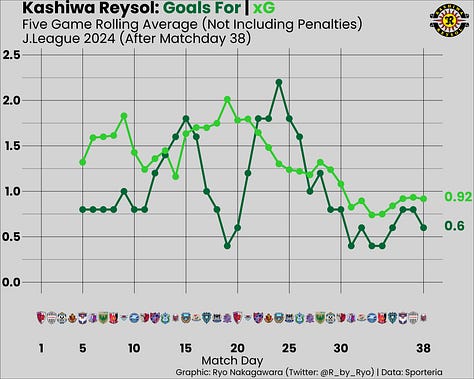


I talked in the mid-season review about Mao Hosoya in particular as very guilty of missing a lot of chances, indeed he finished the season with only 6 goals from 9.85 xG. However, I did also mention that the other aspects of his game were still there, being physical holding up the ball, making good runs, and helping out defensively.




In funny contrast, Kosuke Kinoshita somehow had 10 goals from 12.34 xG this season. I’ve always thought of him as a Lincoln log that somehow learned to play football, so it was a surprise for sure. Otherwise, I would really like to see more of Takuya Shimamura next season, especially starting games instead of his super-sub role. I’ve liked him since his Kumamoto days and he has really good dribbling ability that Reysol lack.
Defensively in open-play, Reysol were a tough nut to crack in their mid-to-low block really suffocating opponent attacks. However, their Achille’s heel was their set-piece defending where they conceded 16 from these situations. A whopping 31% of their total conceded.
Another worrying fact was that Reysol conceded in the 2nd Half of injury time in five consecutive games and dropped 8 points (vs. Machida 10.19, vs. Urawa 10.23, vs. Avispa 11.3, vs. Niigata 11.9, vs. Kobe 11.30). It goes to show you how tight their games are because their attack didn’t finish off chances to put the game away…
Despite this, there are two players in defense that I wanted to highlight, Taiyo Koga and Hiroki Sekine. I’ve been a fan of Koga for quite some time and it’s been a mystery as to why no one else near the top of the J.League has picked him up yet. He has formed a good Center Back partnership with a variety of players and is a fantastic ball progressor from the back-line, interestingly so with both feet.
Hiroki Sekine really caught my eye this season from Right Back. Quite tall for a Full Back and backs it up with being very good in the air. Sekine makes lots of good runs down the flank to support the attack and has a large repertoire of different passes and crosses to create chances. Unfortunately, this has not led to any assists though. His league performances have been rewarded with U-23 caps to win the U-23 Asian Cup along with a starting spot at the Olympics. To cap it all off, Moriyasu called him up to the senior national team twice, albeit both as a back-up after injuries in the initial squad.

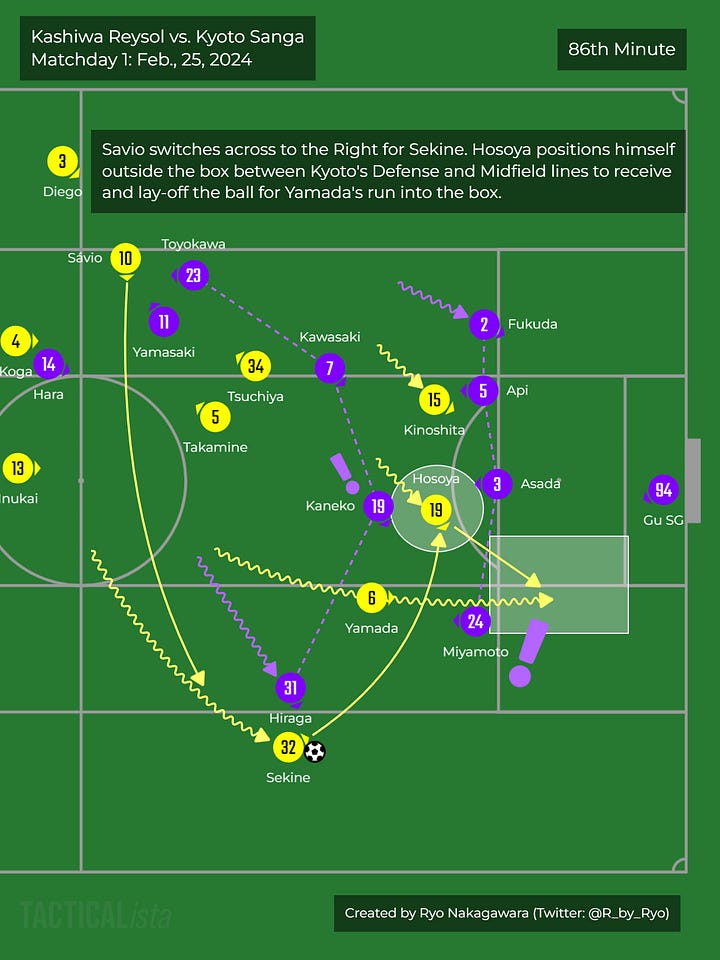

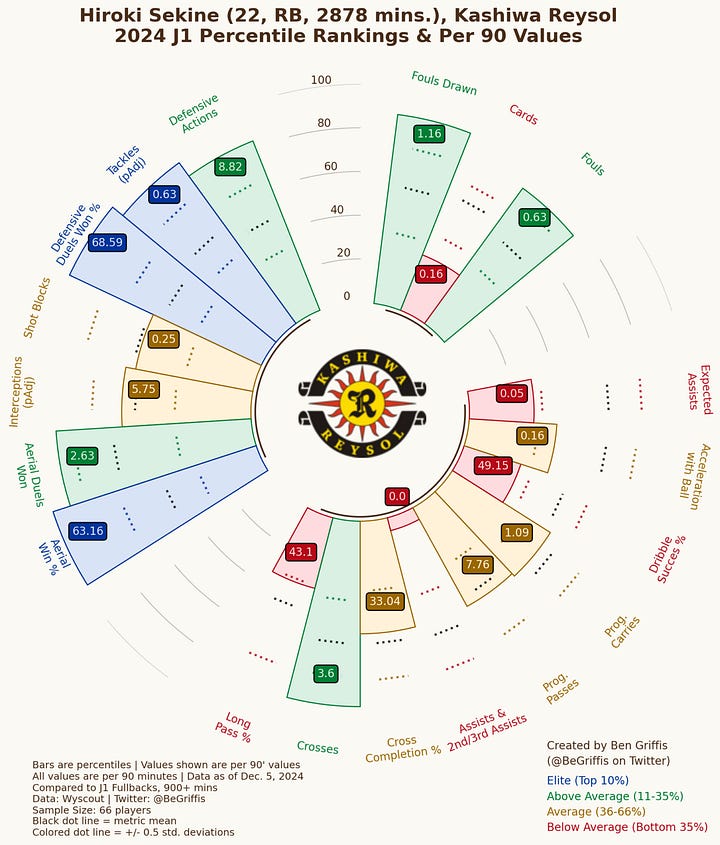
I am rather worried for Reysol as they still can't seem to escape their defend-and-counterattack DNA, one that is extremely reliant on the output of one, maybe two star attackers. With both Mao Hosoya (Europe has been calling him for at least the past two years) and Matheus Savio having all the potential to leave, do Reysol have it enough in them to survive 2025? Despite the decent underlying numbers that I talked about, I’m rather skeptical of Masami Ihara’s continued tenure at the club and worry that without those two stars, Reysol will struggle mightily unless they bring in some very good reinforcements (what will happen to Hayato Tanaka?) and/or rethink their tactics.
NOTE: Ricardo Rodriguez (formerly of Tokushima Vortis & Urawa Reds) has been confirmed as Reysol’s new manager! I feel this also means that Hayato Tanaka is likely to stay at Reysol too.
Other data viz:


Jubilo Iwata (18th, 38 Points)
10 Wins // 8 Draws // 20 Losses
Location // Stadium: Iwata // Yamaha Stadium
Manager: Akinobu Yokouchi
47 Goals (13th); 68 Conceded (tied worst)
38.94 xG (18th); 58.42 xGA (19th)
Top goal scorer: Ryo Germain (15 goals plus 4 penalties)
Goalkeeper: Eiji Kawashima
The biggest surprise of the season was Ryo Germain scoring 19 goals from 14.39 xG (this includes penalties). Unfortunately, that simply wasn’t enough as Jubilo Iwata were relegated straight back to J2. The first half of the season wasn’t great but just they were keeping their heads just above water, however the second half of the season was a disaster with Jubilo resorting to constant long balls and completely abandoning any sort of build-up play. It was rather frustrating to me considering Jubilo were able to mix it up fairly successfully in the 1st half of the season but manager Akinobu Yokouchi seemed to have completely lost his nerve! They were supposed to be a possesion-heavy team but when they panicked and switched over to counterattacking football it was clear their squad just wasn’t suited for that at all…
Summer signing Hassan Hilo's every second touch was a long ball blasted into the opponent half while Germain and Ryo Watanabe were constantly chasing lost causes and fighting for 40/60 (no, not even 50/50) balls and exhausting themselves. Ko Matsubara’s crossing was pretty much the only avenue of chance creation alongside the small trickle of fast counterattacks, it was pretty dire to watch.
Their non-existent attacking threat shows up in the stats, Jubilo Iwata had the least entries into the final 3rd and opposition box per game, all leading to fifth least shots per game according to Football-Lab.


When Ko Matsubara, Rikiya Uehara, and Hiroto Uemura were your biggest attacking threats then clearly something is going wrong here. Even more damning was how Jubilo let Yosuke Furukawa go off to Europe (on a loan and will eventually leave permanently for peanuts I imagine!), and from his perspective I can understand it when the youngster had one single solitary start all season long! Pretty much all of his 744 minutes on the pitch came from off the bench! Perhaps it’s fair to say that Furukawa didn’t meet the requirements, especially defensively, for what Yokouchi wanted from his wide midfielders but when Jubilo just didn’t have a whole lot of attacking impetus at all throughout the season it seemed like such a huge waste.
In addition to the attack, Jubilo were one of the worst teams on the defensive side of things. They hemorhaged a large quantity and quality of shots. While Peixoto was the team’s second best attacker, he apparently wasn’t doing enough to compensate for his lack of defending from the front so he was replaced by Ryo Watanabe in the last few months of the season. Not that this helped as Iwata’s pressing was poor and there was such a huge disconnect between the front players and the rest of the team behind them. It was very easy for opposing teams to play right through and break apart Jubilo’s 4-4-2. On the other hand, Eiji Kawashima did his best, including a massive penalty stop in the last minute to preserve a much needed 3 points vs. Cerezo Osaka in October but it wasn’t enough.
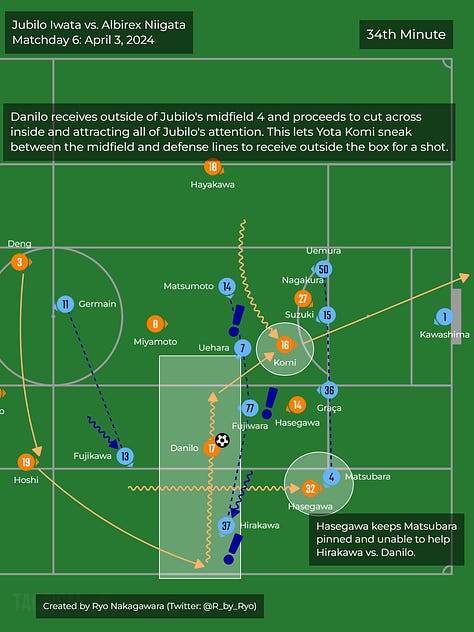




Overall, Iwata were a very mediocre team whose transfer market dealings before the season were a massive failure and they'll have to take big losses on shifting them out if they want to do so. Jordy Croux made a lot of sense on paper (I praised the signing as a logical one when it was announced!) but it didn't work out which yeah unlucky, but that’s football for you. Peixoto was somewhat of a success despite his out-of-possession problems while Leo Gomes was fairly mediocre but did at least win a majority of league minutes ahead of his competition in the squad. Bruno Jose and Weverton were the complete duds and it’s the kind of mistake you can't afford to make as a newly promoted club! Imagine all the J2 players or fringe players from J1 squads they could’ve signed instead and probably for a lot cheaper!
I think Iwata were extremely lucky to sneak into the automatic promotion spot last year and it was mainly due to their rivals Shimizu S-Pulse doing one of the most epic J.League promotion fumbles of all time. I feel like the club as a whole were left scrambling during the off-season. Now heading back into J2, Iwata still have a good J2 level squad so they’ll need to assess, clean house, get ready to win promotion again, and take into account all the mistakes from this season.
Other data viz:





Consadole Sapporo (19th, 37 points)
9 Wins // 10 Draws // 19 Losses
Location // Stadium: Sapporo // Sapporo Dome
Manager: Mischa Petrovic (Serbia/Austria)
43 Goals (19th); 66 Conceded (18th)
35 xG (19th); 54.7 xGA (17th)
Top goal scorer: Yoshiaki Komai, Musashi Suzuki (1 penalty), & Ryota Aoki (all tied on 6 goals)
Goalkeeper: Takanori Sugeno
I've been quite harsh on Sapporo these past few seasons (for good reason!) and it's all finally come to head with their relegation. The signs were all there, if you've actually watched this team play and have been reading my season reviews for the past couple of years! Sapporo defenders (online ones, not the actual defenders on the pitch) can’t even use the “oh well, Sapporo’s attack is still good” line when they scored the second least amount of goals and created the second least amount of xG this season!
The “consensus” online seemed to be that Sapporo were much better in the 2nd Half of the season… but when you look at the data that’s not actually true and this is on top of the fact that they had a much easier schedule “on paper” (well, as easy as it could be for a relegation threatened club). To me, it really seemed like that “spike” in “Goals For” (dark green line) during August~September, even though the actual quality of chances created stayed relatively the same (light green line), gave this weird impression that they became better because they won 3 games in a row.




I was very skeptical of their summer emergency signings and I still think they were just a random grab bag of players without a contract or players recommended by friendly agents. Neither Jordi Sanchez nor Amadou Bakayoko started any games up top while in midfield Francis Cann didn’t even make the bench once! On the other hand, Park Min-Gyu has been a fairly decent addition in defense and even earned a South Korea national team call-up on the back of his good performances for Sapporo.
In the latter half of the season, Sapporo’s attack pretty much turned into Tomoki Kondo making good runs behind and hoping something happens. I’ve been quite impressed by him since he was at Yokohama FC and he’ll be a prime candidate for the remaining J1 teams to pick up on the cheap from Sapporo. Kondo finished the season with 5 goals and 3 assists!



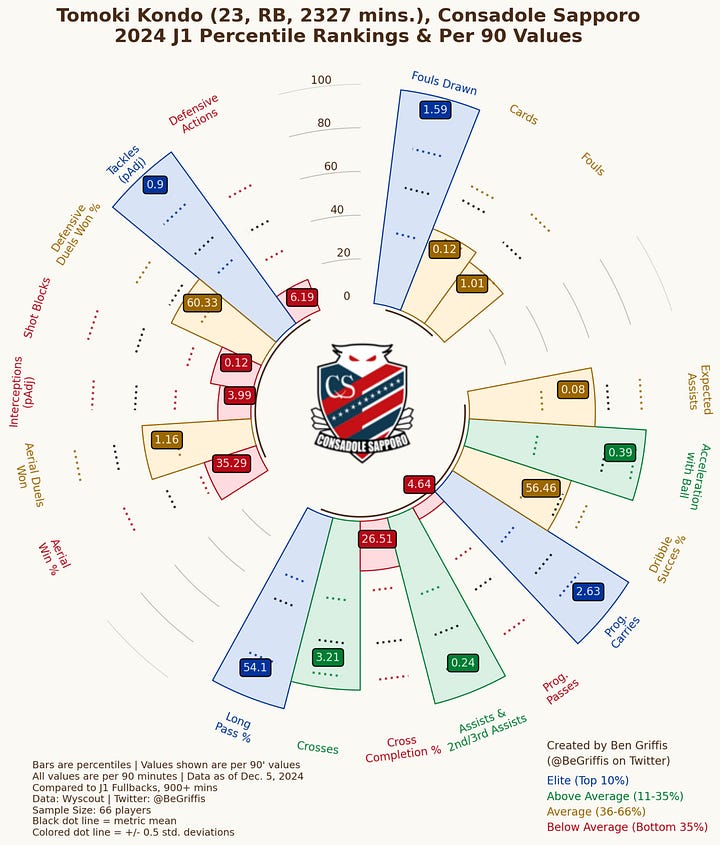
It will surprise a lot of people but Musashi Suzuki actually improved from his absolutely woeful first 2/3rds of the season and slowly contributed more on-and-off the ball as he finished the season with 5 goals plus 1 penalty. Thai star Supachok also had a decent season all things considered but the one thing holding him back is his persistent injury issues so potential J1 buyers should be careful. The other two top scorers for Sapporo were actually Ryota Aoki (again, like in that one weird 2022 season where he got 8) and grizzled veteran Yoshiaki Komai, both on 6 goals.
In defense… the structural and tactical decisions have played a huge part in Sapporo’s catastrophic failures this season (and the past few seasons). Nevertheless, individual contributors such as Daihachi Okamura and Takanori Sugeno really did do their utmost. While I feel the latter should retire soon as he’s over 40 now, Okamura is still one of the stronger and tougher Center Backs in the league and he’ll probably look a lot better than he already does in an more organized defensive set up. I will be very surprised if Okamura remains at Sapporo next season, I’m sure many J1 teams will be after him.

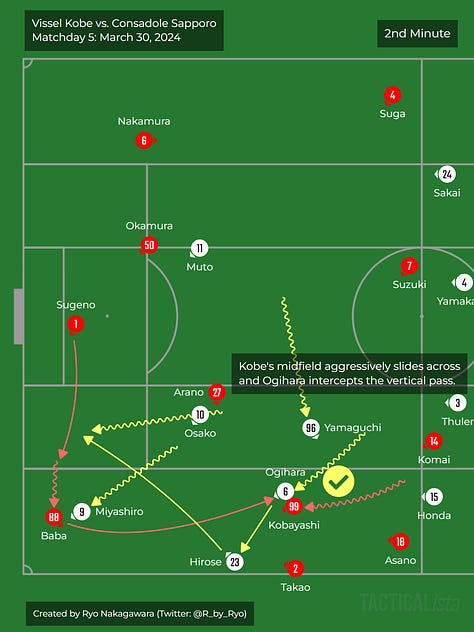

All-in-all it’s a pretty miserable way for Mischa Petrovic to go. His first few seasons at the club were genuinely good and exciting but as good players trickled out, the Austrian never quite could adjust and instead doubled-down on his style of play to his own demise. Like I’ve mentioned, there’s been a times over the past few years that Sapporo were genuinely very lucky to have survived the drop and those should have been warning signs for Mischa to change things up or for Sapporo’s higher-ups to take what would still have been a bold decision to sack him. Now Sapporo are dropping down into J2 where it won’t be nearly so easy to climb back out with the league (and other parts of the Japanese football pyramid) rapidly improving!
Other data viz:



Sagan Tosu (20th, 35 points)
10 Wins // 5 Draws // 23 Losses
Location // Stadium: Tosu // Ekimae Real Estate Stadium
Manager: Kenta Kawai // Kosuke Kitani (from August)
48 Goals (12th); 68 Conceded (tied worst)
41.48 xG (15th); 62.71 xGA (20th)
Top goal scorer: Marcelo Ryan (13 goals plus 1 penalty)
Goalkeeper: Park I.G.
I've been saying for years now that the one big warning sign for Sagan Tosu have been their dreadful underlying defensive numbers (xGA) and this season, even with Park Il-Gyu heroics, the chances conceded in terms of quantity and quality just could not be ignored so Kenta Kawai had to go.


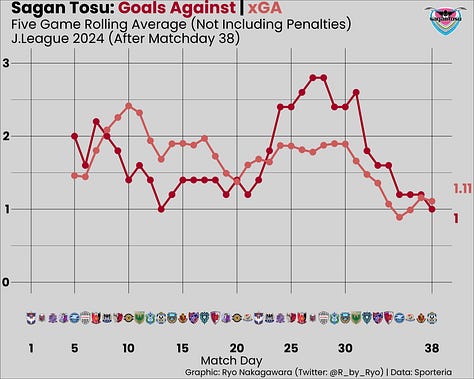
However, Kosuke Kitani wasn’t great either (but he was still able to play FC Tokyo off the park to eek out a 1-1 draw... anyway…). The defense was never fixed and it completely fell apart as, before relegation was confirmed on Matchday 34 (October 19), they only won one game since early July all the way back in matchday 22. Tosu couldn’t even hold onto the ball well anymore which was one of their defining team traits as they finished the season mid-table in terms of average ball possession per game.
Of course, Kitani was forced into a pretty bad situation as the club sold anybody with a semblance of attacking threat besides Marcelo Ryan: Ayumu Yokoyama, Taichi Kikuchi, and Yuichi Naganuma. For those keeping tally, that's 2 out of 3 of the top goal scorers and 4 out of the 5 top assist-ers on the team! On top of that, their midfield general So Kawahara left for Kawasaki Frontale!


In terms of incomings, Lithuanian international Vykintas Slivka was OK while Kenta Nishiya was a decent pick-up from Fujieda MYFC in J2 but he’s had his work cut out along side Akito Fukuta (a veteran player that I really quite like). All this on top of star striker Marcelo Ryan being out injured or suspended for 6 of the last 10 games of the season was a real blow for Kitani to be able to do anything.
They had done really well punching above their weight for this long. However, the warnings signs were there and the inability to tweak their playing style to cover their (huge!) defensive frailties even a little bit came back to bite them. Tosu finished 3 points behind 18th Iwata and 6 points behind 17th Kashiwa Reysol but it only looks this close because they won a few games after they were officially relegated… Perhaps the drop down to J2 will give more chances to guys like Shota Hino, Daichi Suzuki and other youngsters as Tosu will need to shed the wage bill (even though I imagine they have one of the lowest J1 wage bills already).
Other data viz:

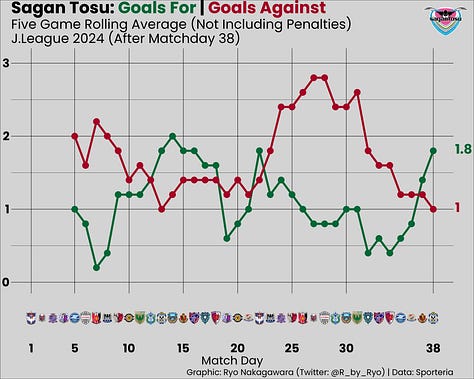

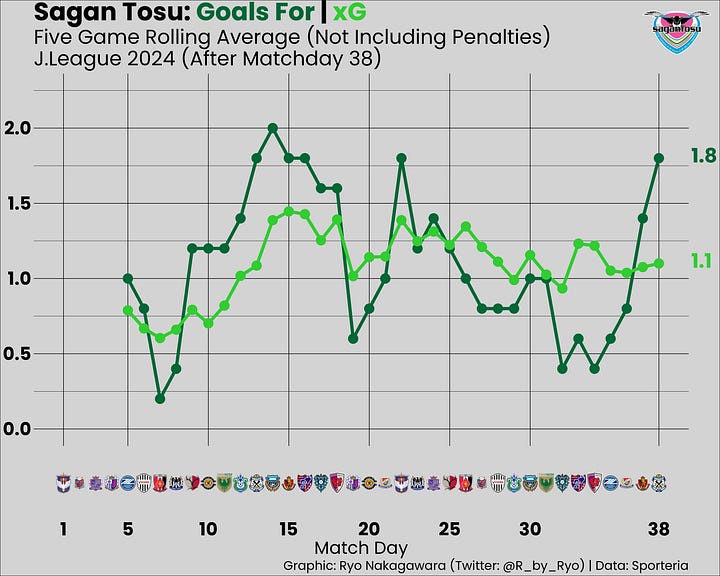

Squad Age Profiles
I changed the calculation of a squad's median age up a bit by simply taking into account only players that have played 50% of more of total possible league minutes. This is so when looking at the 'average' age of a team, we're doing a better job of considering players who are regulars in the team. I am not sure how other people might do it but from playing around with the raw data it looks OK, most teams have around 9~12 players that meet this threshold so I do think I'm capturing the right selection of players in any given team.
Anyway, here's the list of the U-23 players in the league with the most minutes played so far this season (filtered for those that have played more than 50% of total possible league minutes). You might want to keep an eye on these guys in the short-to-medium term. One of the simplest ways to judge a player’s quality is minutes played. It doesn’t matter how much talent you have or how much potential if, in the end, you don’t actually see minutes on the pitch to show it off!
Time Interval
Ideally I would use a 15 minute interval so I could get rid of that one weird section straddling both halves (40-50th minute) but this was the easiest data set I could get. What's noticeable from this data set is that the good teams generally know how to close out a game and don’t concede many goals in the last 10~20 minutes.
Scoring Situations
Ideally, I would have data that concerns all shots or xG accumulated from different match situations as that would mean a much larger sample of data to power any insights (as goals are only the end result and may not give us information about a team's actual performance).
Team Shot Quantity & Team Shot Quality
In the previous few sections we got to know a lot about the goals that J.League teams scored. However, in a sport like soccer/football goals are hard to come by, they might not really accurately represent a team’s actual ability or performance (even if ultimately, it's the end result that matters). To take things one step further I was able to gather data from Sporteria on shot quantity to dive a bit more into team performances. I’ve reversed the order of some of the stats in these next few plots so that in all cases the top right is best and bottom left is the worst teams when looking at their respective stats.
So, what exactly is expected goals (xG)? Expected goals is a statistic where a model assigns a probability (between 0 and 1) that a shot taken will result in a goal based on a variety of variables and is used for evaluating the quality of chances and predicting players’ and teams’ future performances. A xG model only looks at the variables up to the point that the player touches the ball for a shot. Post-shot xG models covers the information about where in the frame of the goal the shot went (“post” as in all the information after the player touches the ball for the shot) but I won’t cover that here.
For some quick primers on xG check the links below:
The following two sections use xG data from Football-Lab. I’m not privy to all of what goes into their model but the explanation page on their website (in Japanese) tells us about some of the information they used:
Distance from goal?
Angle from goal line?
Aerial duel?
Body part used?
Number of touches? (one touch, more than two touches, set plays, etc.)
Play situation? (Corner kick, direct/indirect free kick, open play, etc.)
So, the usual variables that you might recognize from other xG models are being considered. Combining shot quantity and shot quality numbers gives you a much better idea about a team’s performance on either side of the ball.


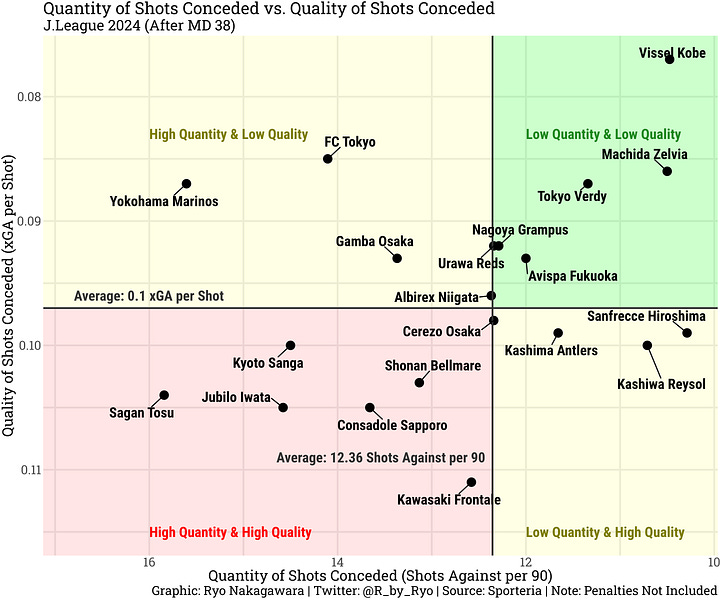

xG Difference
xG Difference is pretty much the same thing as Goal Difference except that we use xG and xGA rather than goals and goals against. This lets us see very quickly which teams generally outperformed their opponents in terms of quality of chances created to quality of chances conceded based on a xG model. This time around I also included the team's results inside the bubble points. So it's easier to see whether a team that had a positive xGD in a specific match couldn't manage to win the game or vice-versa. You ideally want to be below the diagonal line and winning (W) these games as well.
Five Match Rolling Averages
Goals vs. Goals Against
xG vs. xGA
xG vs. Goals
xGA vs. Goals Against
Summary
The 2024 J.League season brought a bunch of surprises from the upstarts Machida Zelvia (and later in the season, Tokyo Verdy) at one end of the table. Some clubs improved like Gamba Osaka shooting up into 4th after a pretty wretched 2023 campaign while others got worse such as the mid-table floundering of the usual J1 giants like Kawasaki Frontale, Yokohama F. Marinos, and Urawa Reds. However, it was the usual suspects drawn into the relegation fight with Jubilo Iwata going straight back down along with Consadole Sapporo and Sagan Tosu.
Hopefully this review gave some insight to all the teams across the J.League in the 2024 season. Next season will be the last before the transition to an Autumn-Spring schedule!
Thanks for reading!




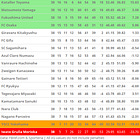







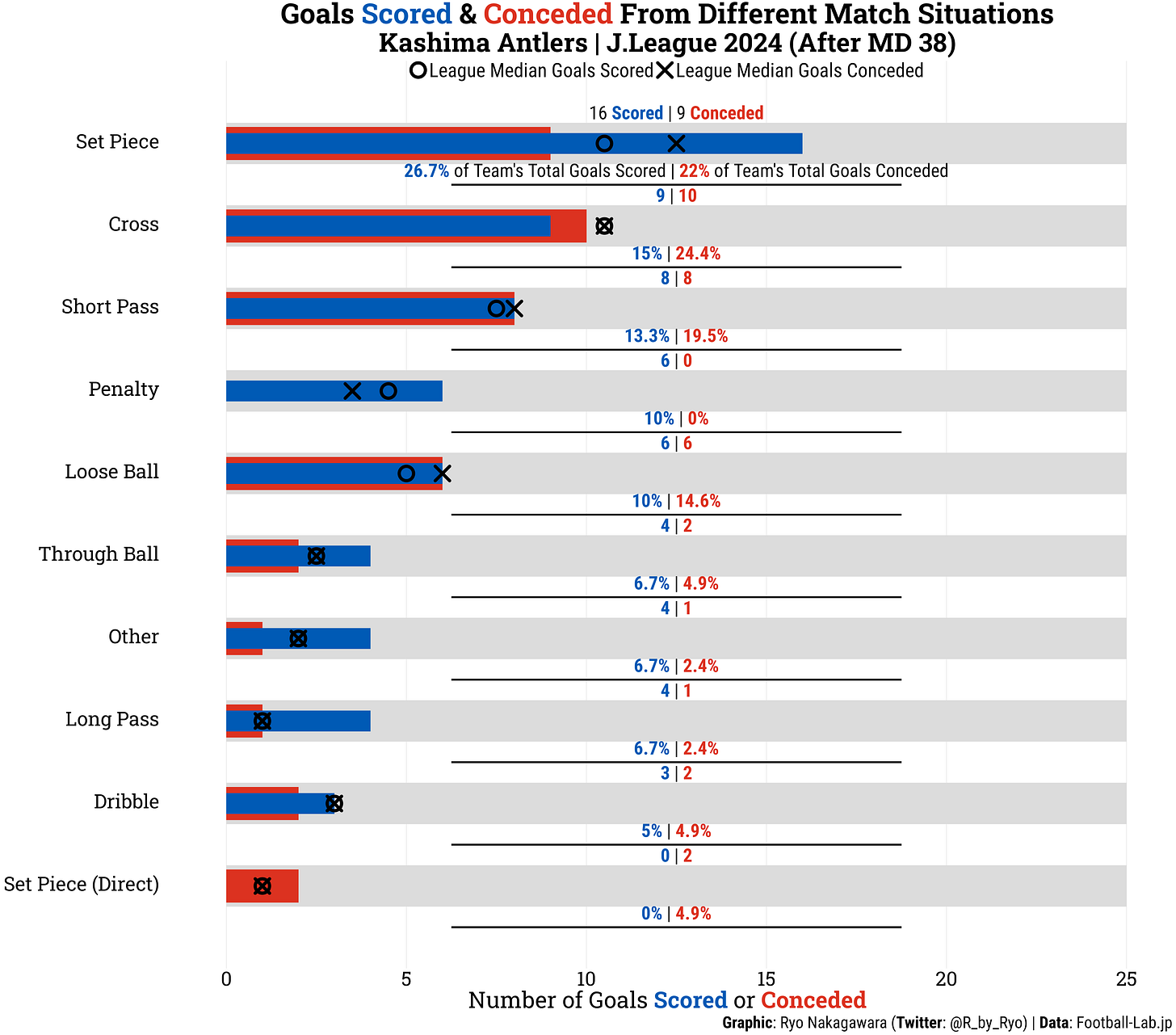
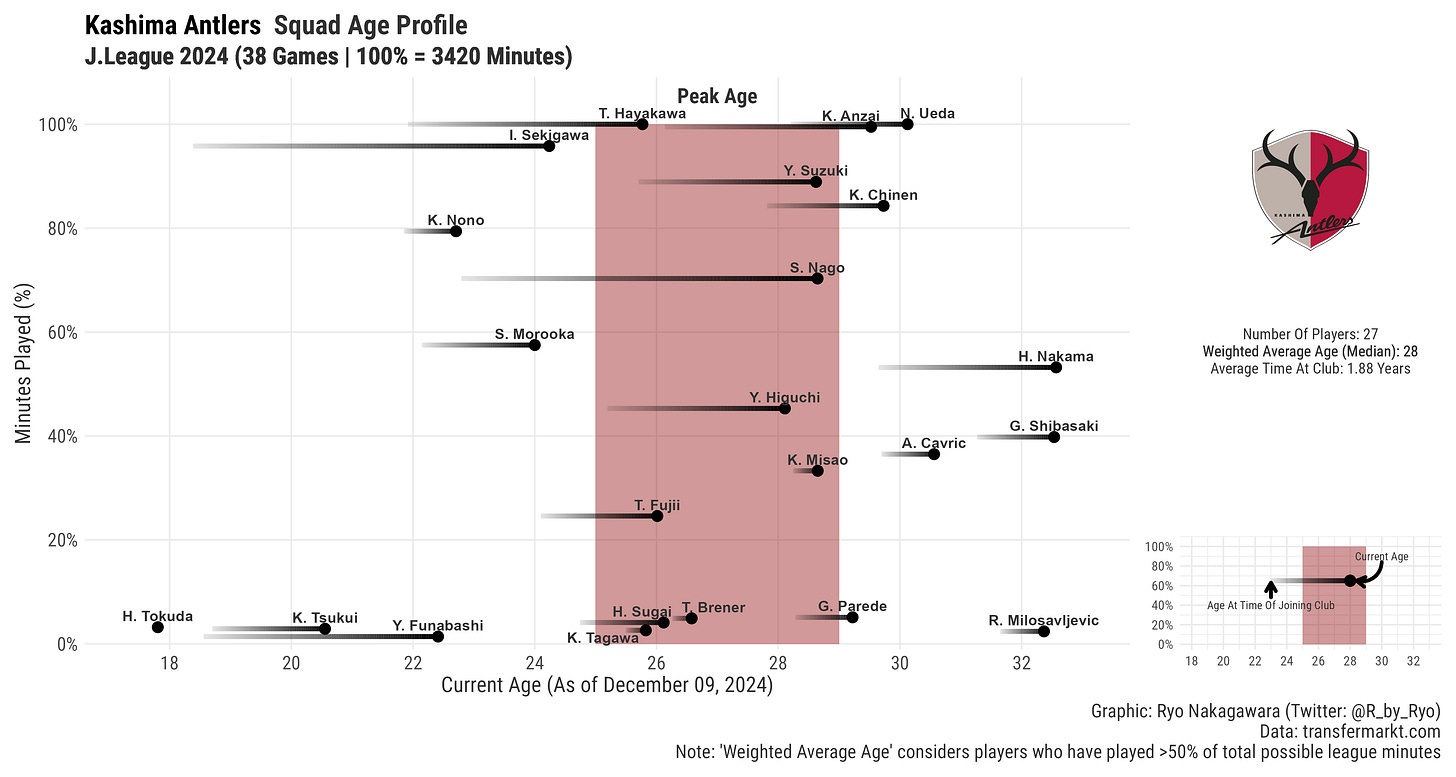

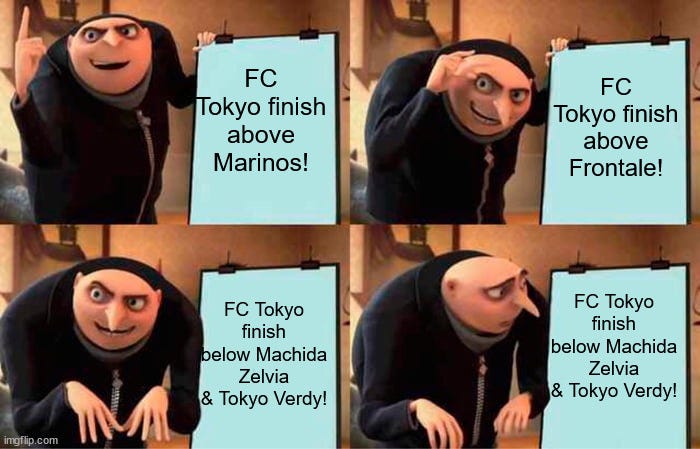






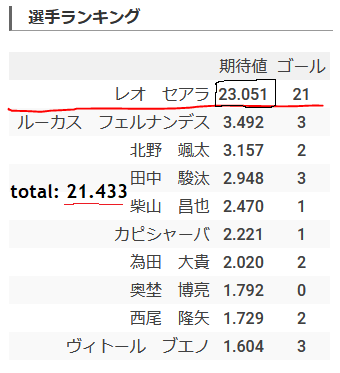





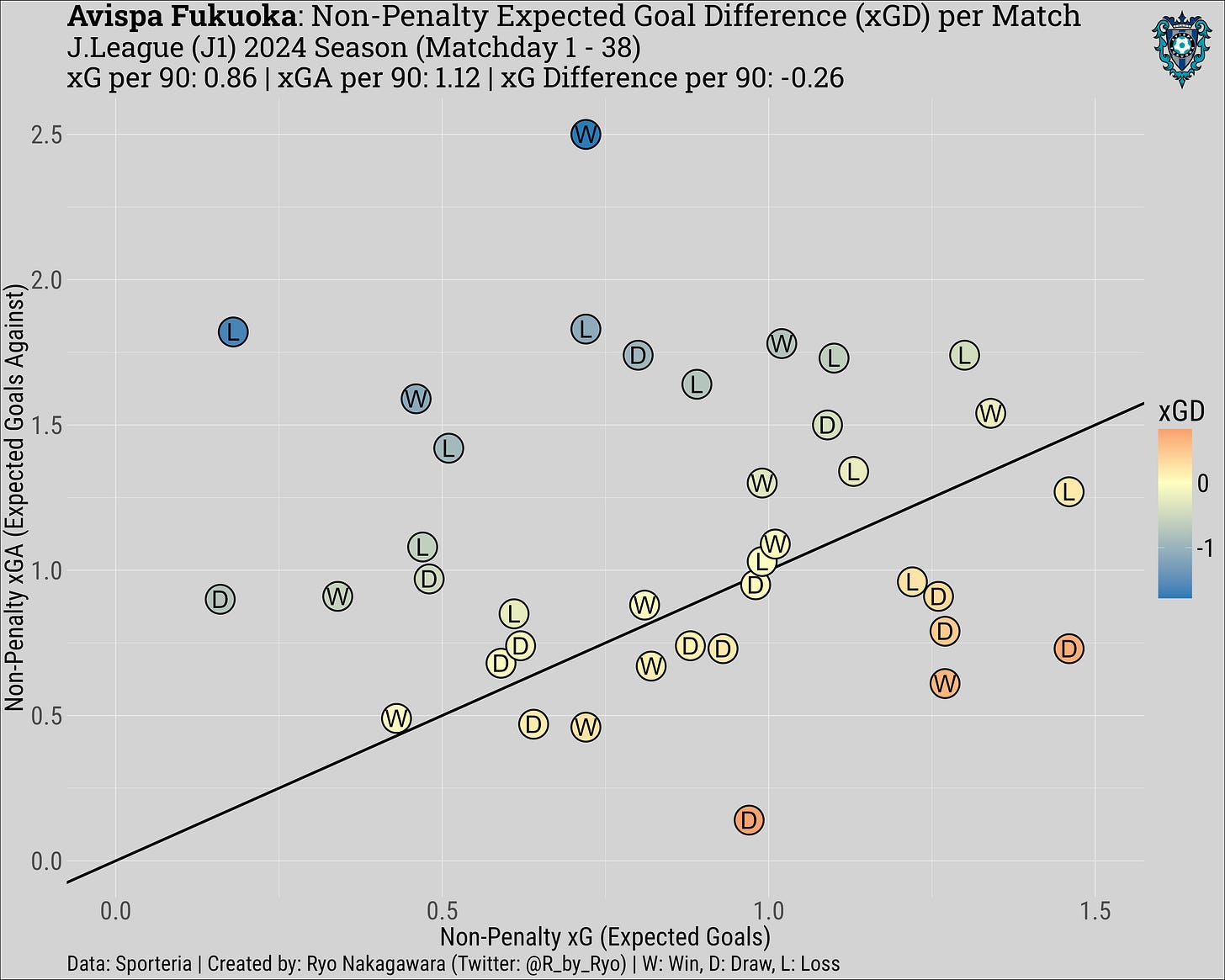





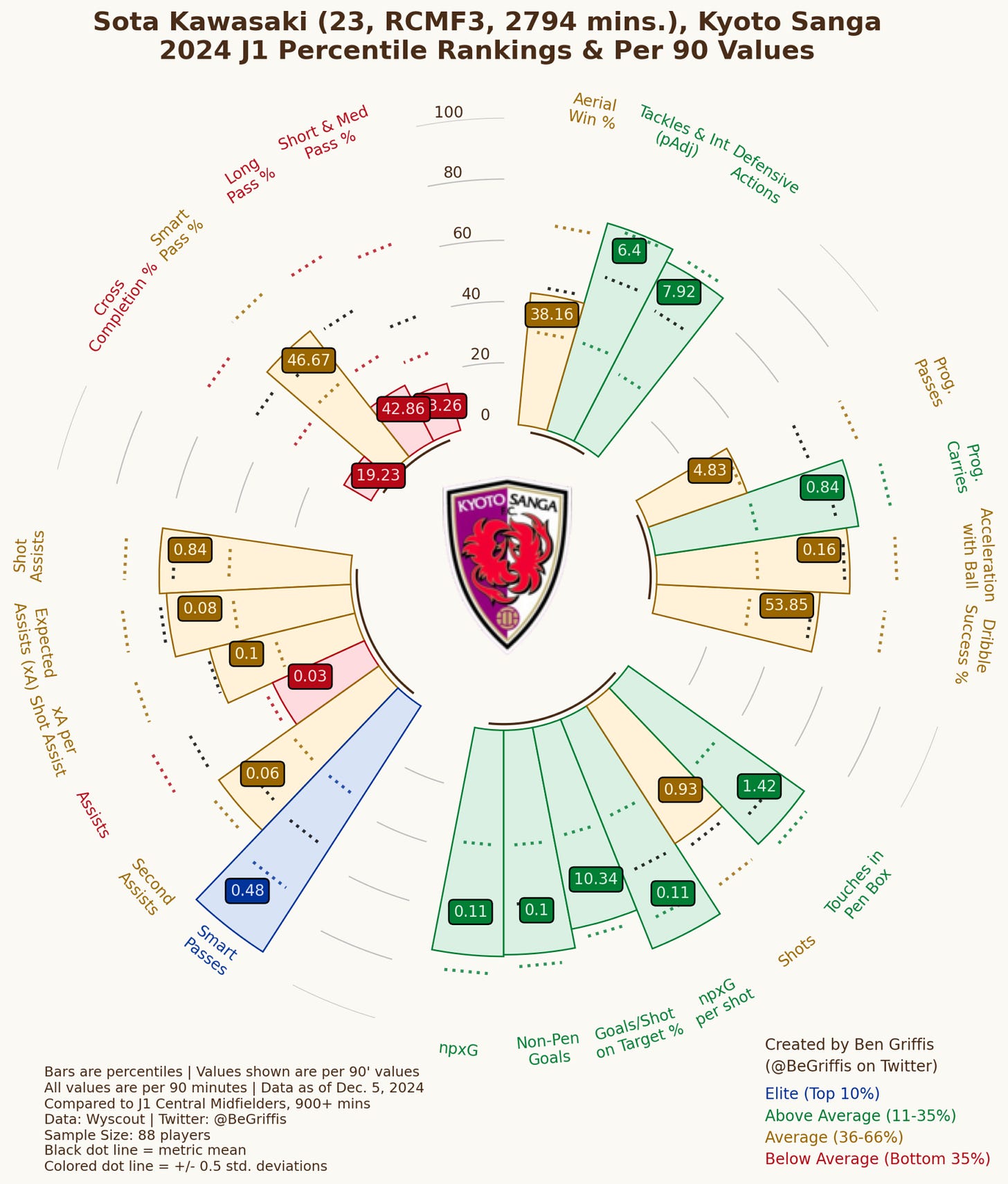




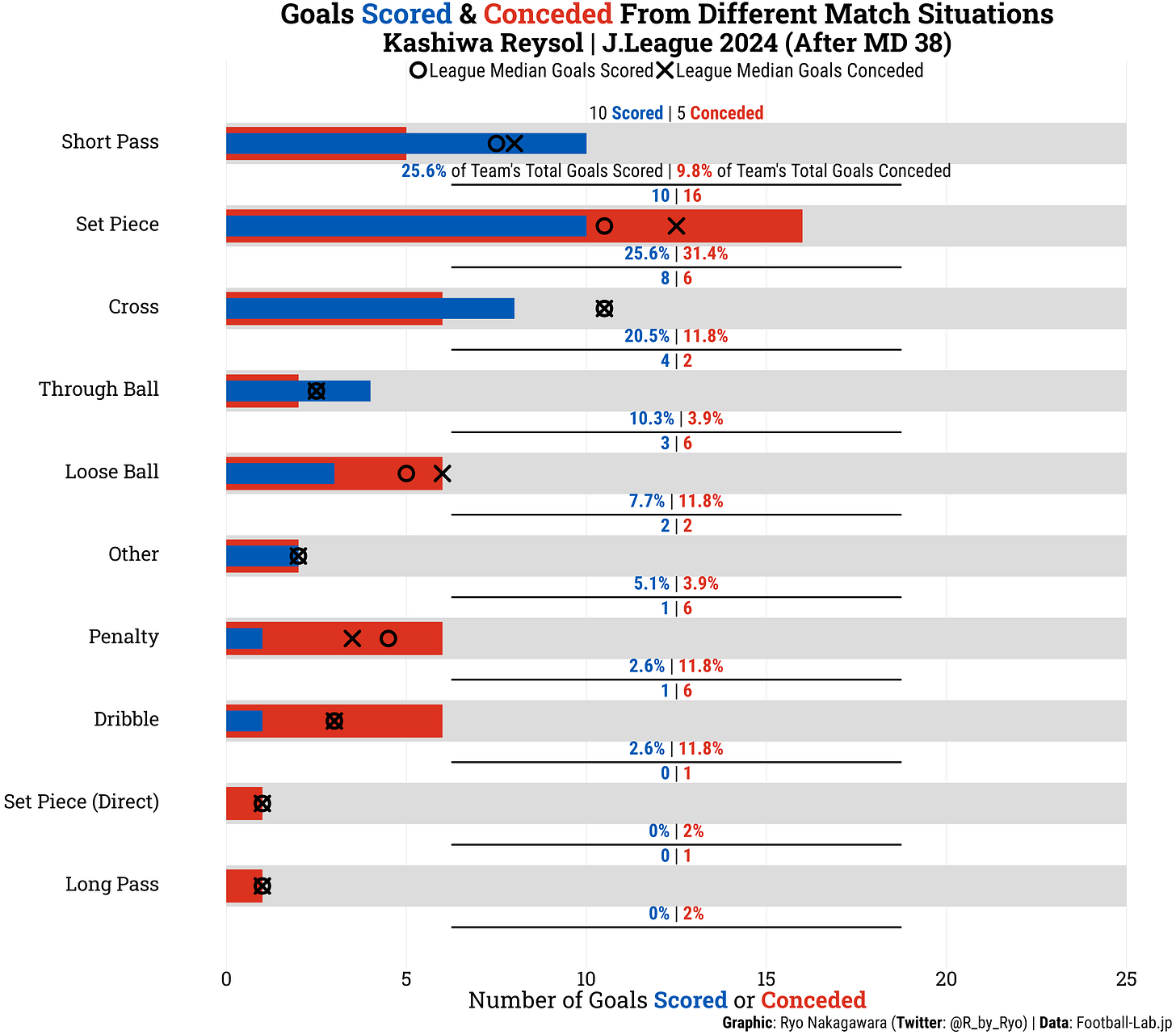

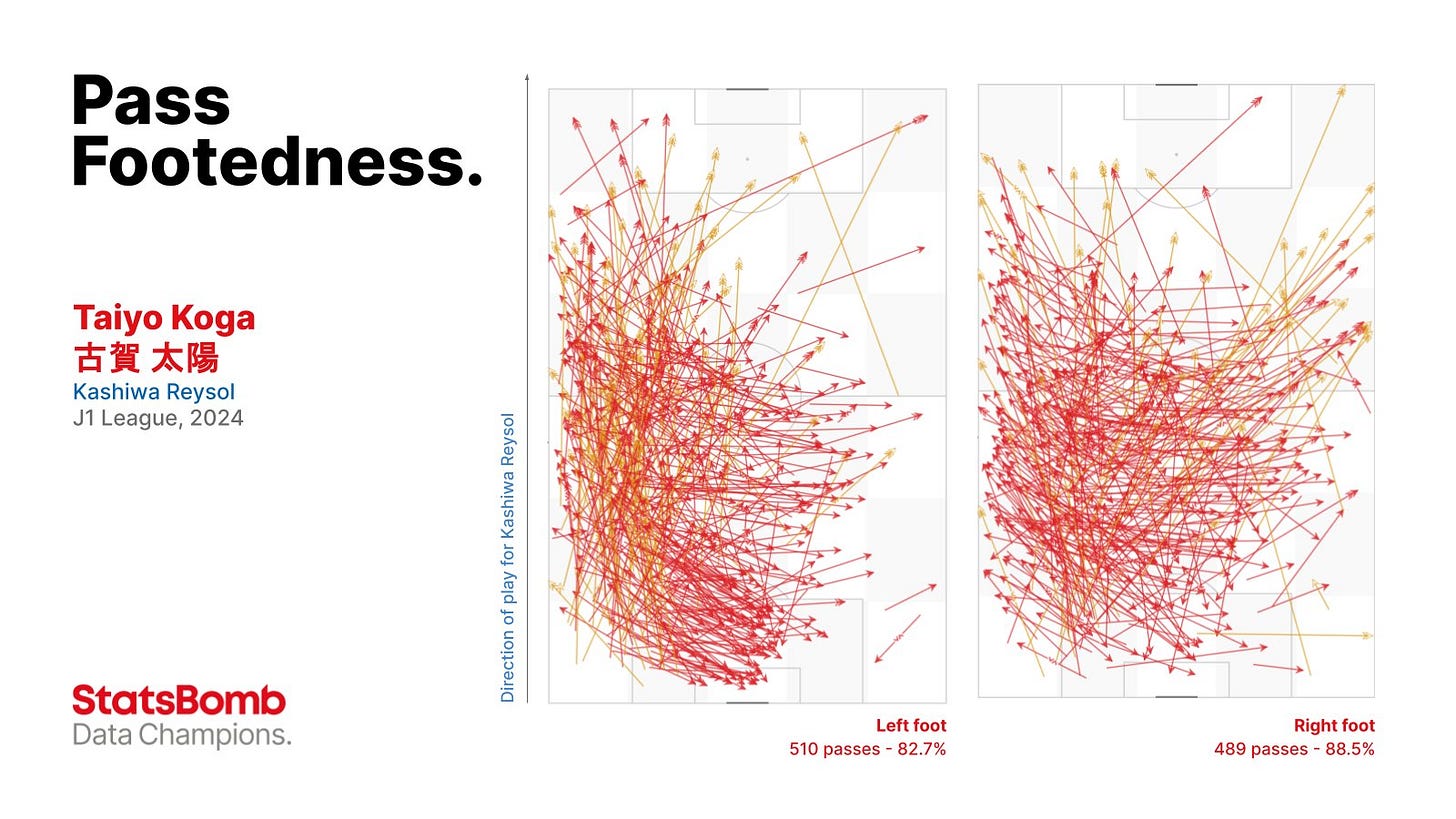



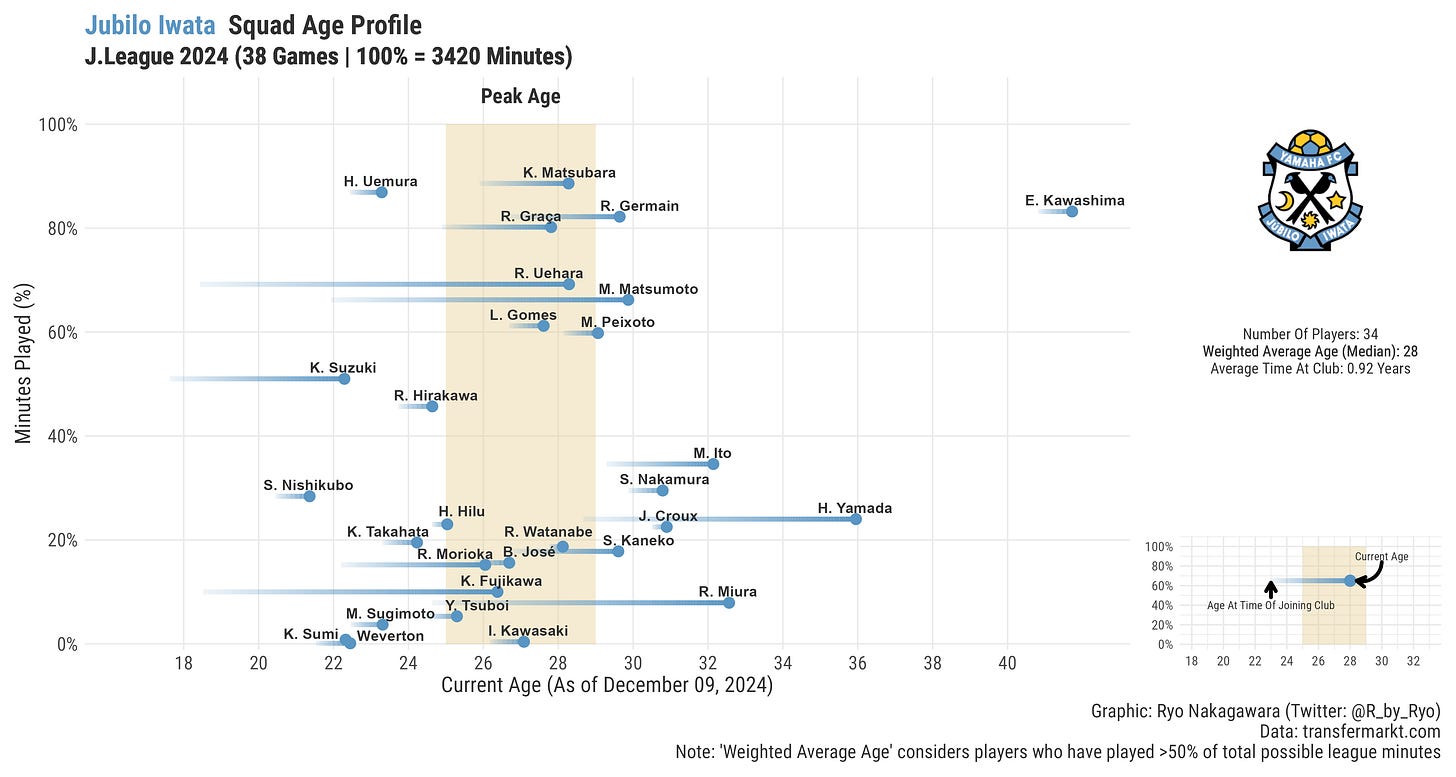
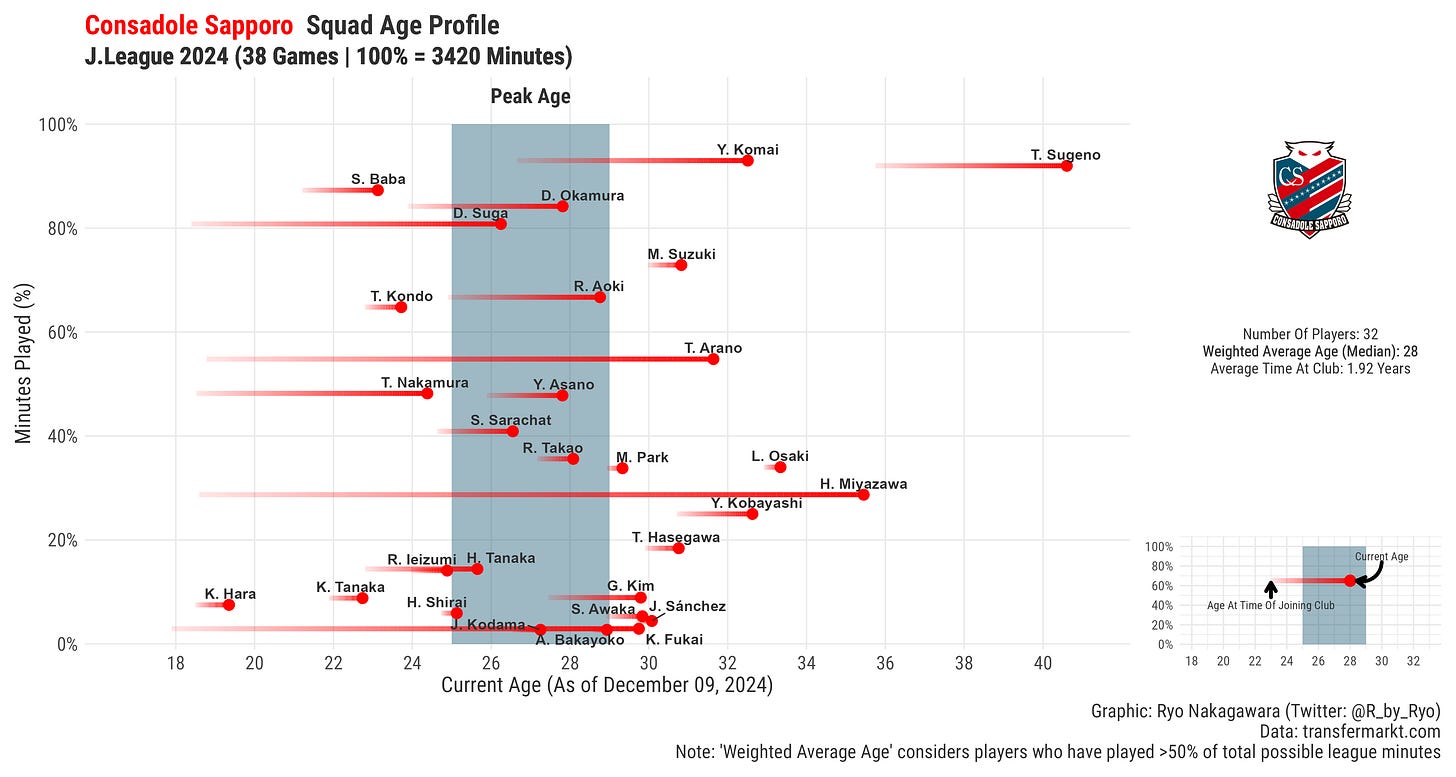





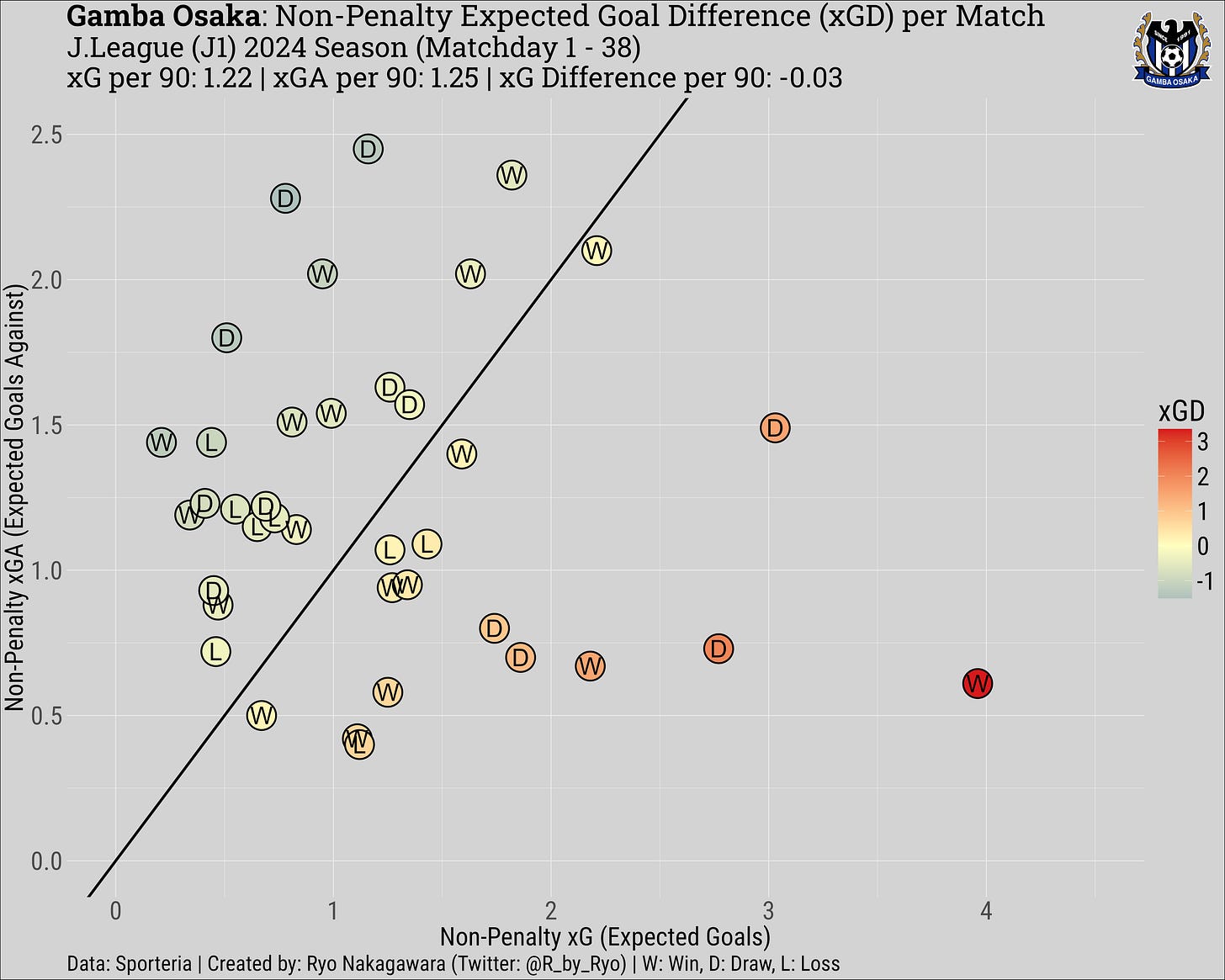




Hi Ryo! Loved the season review you did and all the data viz, they're really complete. I've just downloaded the Hudl physical and event data to play a little with football analytics and your posts will help me a lot to have a better understanding about japanese teams and players, since I don't follow the league